Analysis of Management Accounting Systems for Sustainable Business
VerifiedAdded on 2023/01/19
|19
|5360
|41
Report
AI Summary
This report delves into the principles and practices of management accounting, using CORUS, a steel manufacturing company, as a case study. It examines the core concepts of management accounting, including planning, decision-making, and control, highlighting the differences between management and financial accounting. The report explores various management accounting systems, such as inventory management and cost accounting, detailing their benefits and applications. It then analyzes different reporting methods like budget reports, accounts receivables ageing reports, cost reports, and inventory reports, emphasizing their roles in decision-making and operational efficiency. Furthermore, the report reflects on income statement preparation using marginal and absorption costing, evaluates planning tools in budgetary control, and showcases how management accounting techniques help address financial problems and achieve sustainable success within CORUS. The analysis covers the importance of inventory management, cost accounting systems, and the use of price optimization to enhance business outcomes. The report concludes by summarizing the significance of management accounting in guiding business operations and fostering financial stability.
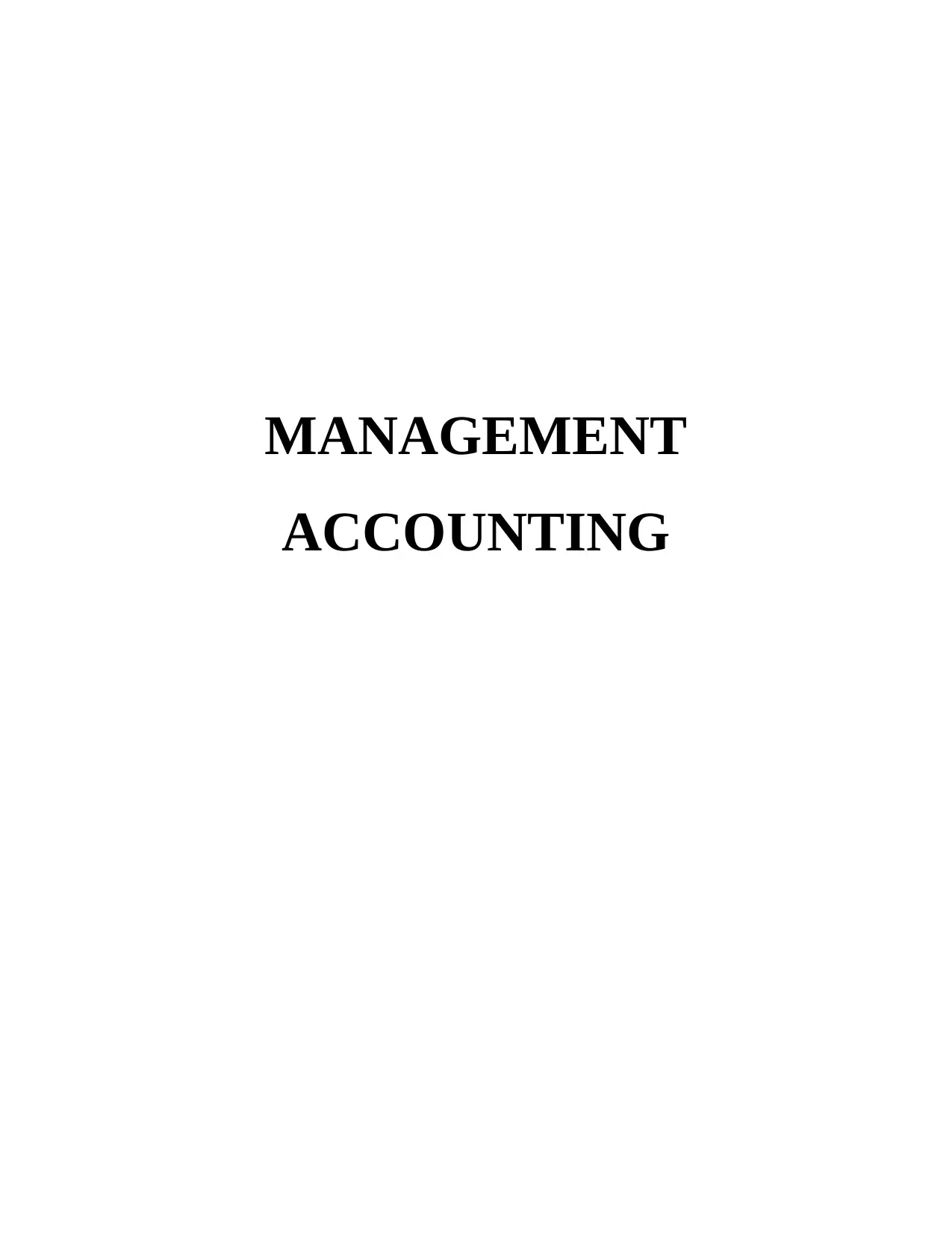
MANAGEMENT
ACCOUNTING
ACCOUNTING
Secure Best Marks with AI Grader
Need help grading? Try our AI Grader for instant feedback on your assignments.
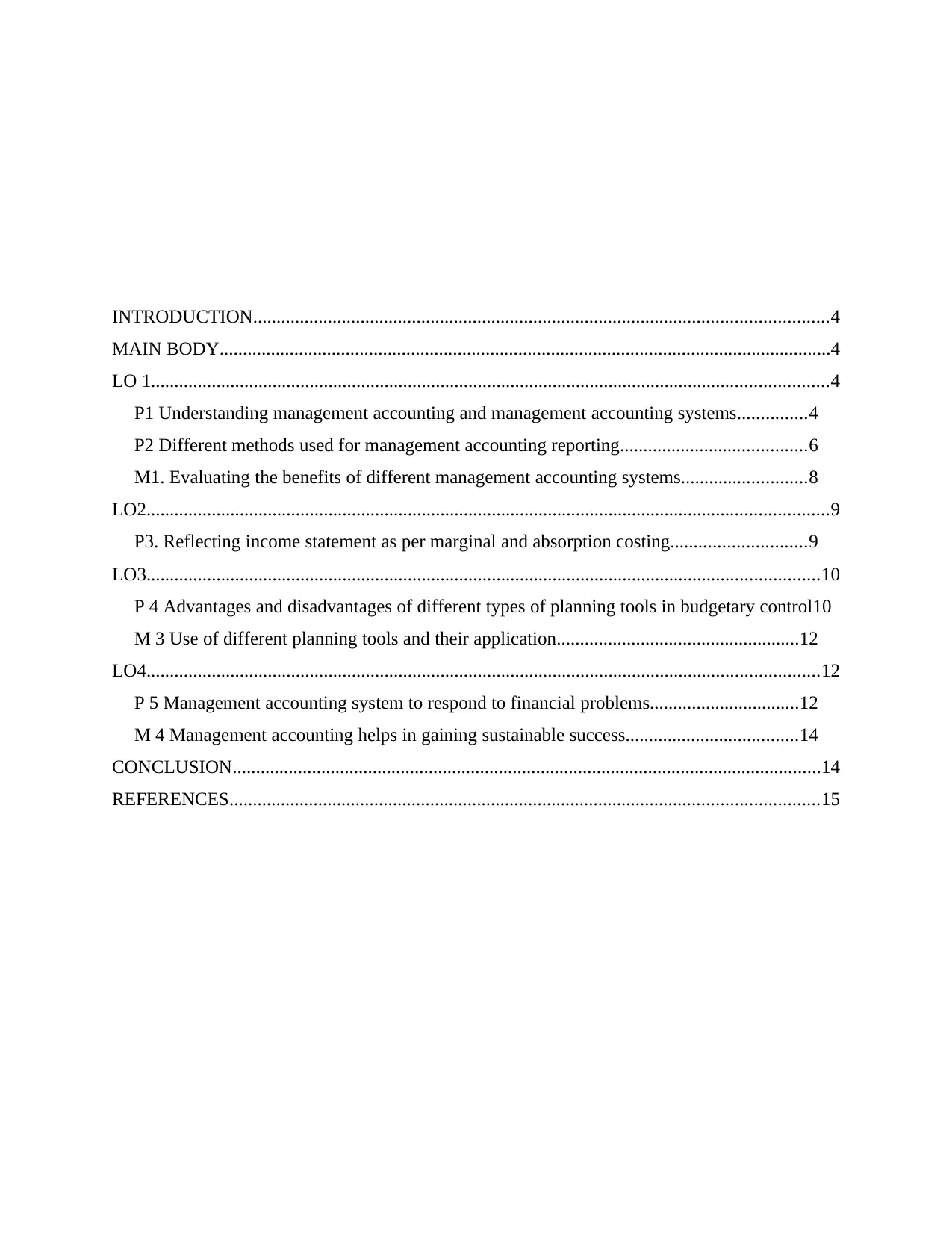
INTRODUCTION...........................................................................................................................4
MAIN BODY...................................................................................................................................4
LO 1.................................................................................................................................................4
P1 Understanding management accounting and management accounting systems...............4
P2 Different methods used for management accounting reporting........................................6
M1. Evaluating the benefits of different management accounting systems...........................8
LO2..................................................................................................................................................9
P3. Reflecting income statement as per marginal and absorption costing.............................9
LO3................................................................................................................................................10
P 4 Advantages and disadvantages of different types of planning tools in budgetary control10
M 3 Use of different planning tools and their application....................................................12
LO4................................................................................................................................................12
P 5 Management accounting system to respond to financial problems................................12
M 4 Management accounting helps in gaining sustainable success.....................................14
CONCLUSION..............................................................................................................................14
REFERENCES..............................................................................................................................15
MAIN BODY...................................................................................................................................4
LO 1.................................................................................................................................................4
P1 Understanding management accounting and management accounting systems...............4
P2 Different methods used for management accounting reporting........................................6
M1. Evaluating the benefits of different management accounting systems...........................8
LO2..................................................................................................................................................9
P3. Reflecting income statement as per marginal and absorption costing.............................9
LO3................................................................................................................................................10
P 4 Advantages and disadvantages of different types of planning tools in budgetary control10
M 3 Use of different planning tools and their application....................................................12
LO4................................................................................................................................................12
P 5 Management accounting system to respond to financial problems................................12
M 4 Management accounting helps in gaining sustainable success.....................................14
CONCLUSION..............................................................................................................................14
REFERENCES..............................................................................................................................15
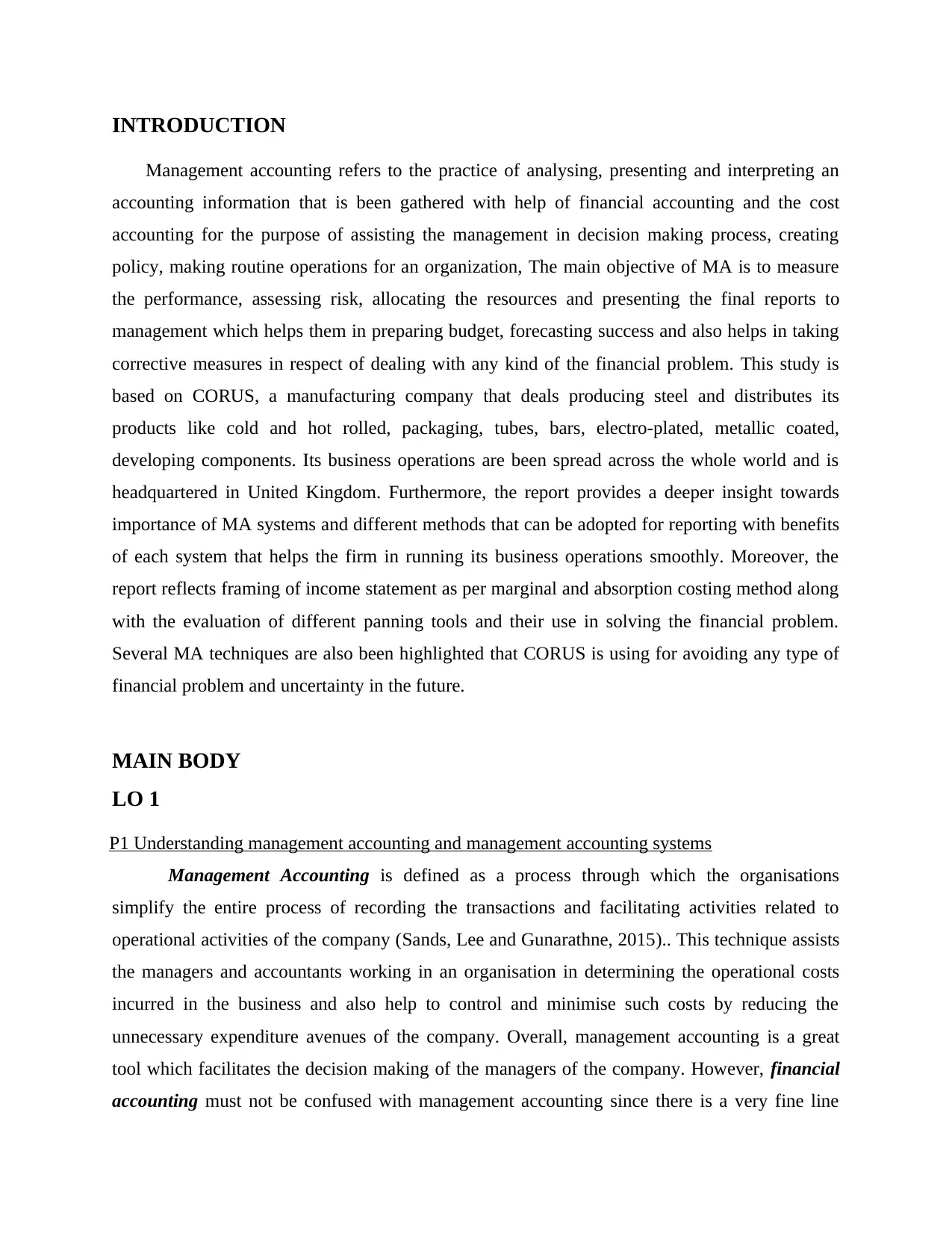
INTRODUCTION
Management accounting refers to the practice of analysing, presenting and interpreting an
accounting information that is been gathered with help of financial accounting and the cost
accounting for the purpose of assisting the management in decision making process, creating
policy, making routine operations for an organization, The main objective of MA is to measure
the performance, assessing risk, allocating the resources and presenting the final reports to
management which helps them in preparing budget, forecasting success and also helps in taking
corrective measures in respect of dealing with any kind of the financial problem. This study is
based on CORUS, a manufacturing company that deals producing steel and distributes its
products like cold and hot rolled, packaging, tubes, bars, electro-plated, metallic coated,
developing components. Its business operations are been spread across the whole world and is
headquartered in United Kingdom. Furthermore, the report provides a deeper insight towards
importance of MA systems and different methods that can be adopted for reporting with benefits
of each system that helps the firm in running its business operations smoothly. Moreover, the
report reflects framing of income statement as per marginal and absorption costing method along
with the evaluation of different panning tools and their use in solving the financial problem.
Several MA techniques are also been highlighted that CORUS is using for avoiding any type of
financial problem and uncertainty in the future.
MAIN BODY
LO 1
P1 Understanding management accounting and management accounting systems
Management Accounting is defined as a process through which the organisations
simplify the entire process of recording the transactions and facilitating activities related to
operational activities of the company (Sands, Lee and Gunarathne, 2015).. This technique assists
the managers and accountants working in an organisation in determining the operational costs
incurred in the business and also help to control and minimise such costs by reducing the
unnecessary expenditure avenues of the company. Overall, management accounting is a great
tool which facilitates the decision making of the managers of the company. However, financial
accounting must not be confused with management accounting since there is a very fine line
Management accounting refers to the practice of analysing, presenting and interpreting an
accounting information that is been gathered with help of financial accounting and the cost
accounting for the purpose of assisting the management in decision making process, creating
policy, making routine operations for an organization, The main objective of MA is to measure
the performance, assessing risk, allocating the resources and presenting the final reports to
management which helps them in preparing budget, forecasting success and also helps in taking
corrective measures in respect of dealing with any kind of the financial problem. This study is
based on CORUS, a manufacturing company that deals producing steel and distributes its
products like cold and hot rolled, packaging, tubes, bars, electro-plated, metallic coated,
developing components. Its business operations are been spread across the whole world and is
headquartered in United Kingdom. Furthermore, the report provides a deeper insight towards
importance of MA systems and different methods that can be adopted for reporting with benefits
of each system that helps the firm in running its business operations smoothly. Moreover, the
report reflects framing of income statement as per marginal and absorption costing method along
with the evaluation of different panning tools and their use in solving the financial problem.
Several MA techniques are also been highlighted that CORUS is using for avoiding any type of
financial problem and uncertainty in the future.
MAIN BODY
LO 1
P1 Understanding management accounting and management accounting systems
Management Accounting is defined as a process through which the organisations
simplify the entire process of recording the transactions and facilitating activities related to
operational activities of the company (Sands, Lee and Gunarathne, 2015).. This technique assists
the managers and accountants working in an organisation in determining the operational costs
incurred in the business and also help to control and minimise such costs by reducing the
unnecessary expenditure avenues of the company. Overall, management accounting is a great
tool which facilitates the decision making of the managers of the company. However, financial
accounting must not be confused with management accounting since there is a very fine line
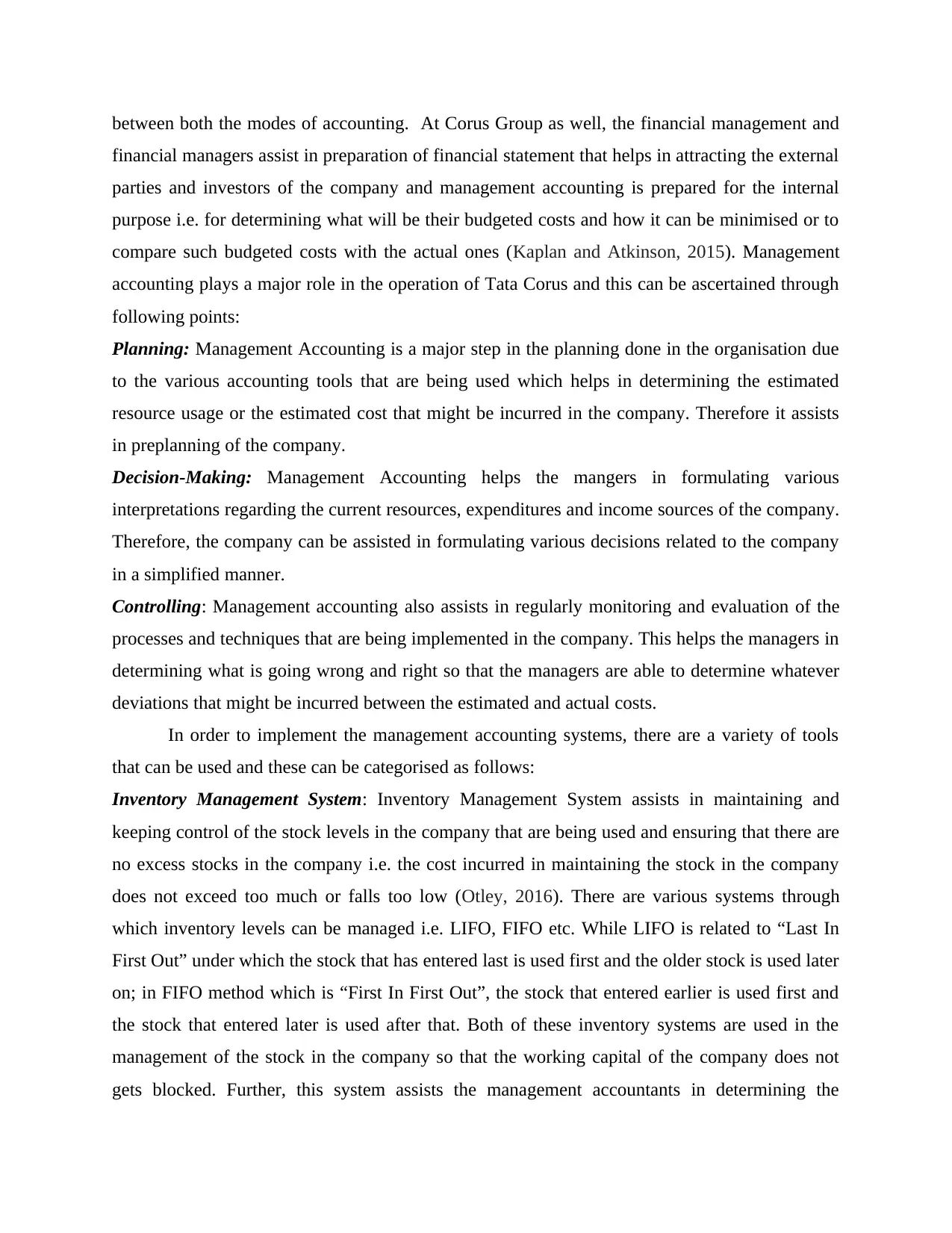
between both the modes of accounting. At Corus Group as well, the financial management and
financial managers assist in preparation of financial statement that helps in attracting the external
parties and investors of the company and management accounting is prepared for the internal
purpose i.e. for determining what will be their budgeted costs and how it can be minimised or to
compare such budgeted costs with the actual ones (Kaplan and Atkinson, 2015). Management
accounting plays a major role in the operation of Tata Corus and this can be ascertained through
following points:
Planning: Management Accounting is a major step in the planning done in the organisation due
to the various accounting tools that are being used which helps in determining the estimated
resource usage or the estimated cost that might be incurred in the company. Therefore it assists
in preplanning of the company.
Decision-Making: Management Accounting helps the mangers in formulating various
interpretations regarding the current resources, expenditures and income sources of the company.
Therefore, the company can be assisted in formulating various decisions related to the company
in a simplified manner.
Controlling: Management accounting also assists in regularly monitoring and evaluation of the
processes and techniques that are being implemented in the company. This helps the managers in
determining what is going wrong and right so that the managers are able to determine whatever
deviations that might be incurred between the estimated and actual costs.
In order to implement the management accounting systems, there are a variety of tools
that can be used and these can be categorised as follows:
Inventory Management System: Inventory Management System assists in maintaining and
keeping control of the stock levels in the company that are being used and ensuring that there are
no excess stocks in the company i.e. the cost incurred in maintaining the stock in the company
does not exceed too much or falls too low (Otley, 2016). There are various systems through
which inventory levels can be managed i.e. LIFO, FIFO etc. While LIFO is related to “Last In
First Out” under which the stock that has entered last is used first and the older stock is used later
on; in FIFO method which is “First In First Out”, the stock that entered earlier is used first and
the stock that entered later is used after that. Both of these inventory systems are used in the
management of the stock in the company so that the working capital of the company does not
gets blocked. Further, this system assists the management accountants in determining the
financial managers assist in preparation of financial statement that helps in attracting the external
parties and investors of the company and management accounting is prepared for the internal
purpose i.e. for determining what will be their budgeted costs and how it can be minimised or to
compare such budgeted costs with the actual ones (Kaplan and Atkinson, 2015). Management
accounting plays a major role in the operation of Tata Corus and this can be ascertained through
following points:
Planning: Management Accounting is a major step in the planning done in the organisation due
to the various accounting tools that are being used which helps in determining the estimated
resource usage or the estimated cost that might be incurred in the company. Therefore it assists
in preplanning of the company.
Decision-Making: Management Accounting helps the mangers in formulating various
interpretations regarding the current resources, expenditures and income sources of the company.
Therefore, the company can be assisted in formulating various decisions related to the company
in a simplified manner.
Controlling: Management accounting also assists in regularly monitoring and evaluation of the
processes and techniques that are being implemented in the company. This helps the managers in
determining what is going wrong and right so that the managers are able to determine whatever
deviations that might be incurred between the estimated and actual costs.
In order to implement the management accounting systems, there are a variety of tools
that can be used and these can be categorised as follows:
Inventory Management System: Inventory Management System assists in maintaining and
keeping control of the stock levels in the company that are being used and ensuring that there are
no excess stocks in the company i.e. the cost incurred in maintaining the stock in the company
does not exceed too much or falls too low (Otley, 2016). There are various systems through
which inventory levels can be managed i.e. LIFO, FIFO etc. While LIFO is related to “Last In
First Out” under which the stock that has entered last is used first and the older stock is used later
on; in FIFO method which is “First In First Out”, the stock that entered earlier is used first and
the stock that entered later is used after that. Both of these inventory systems are used in the
management of the stock in the company so that the working capital of the company does not
gets blocked. Further, this system assists the management accountants in determining the
Secure Best Marks with AI Grader
Need help grading? Try our AI Grader for instant feedback on your assignments.
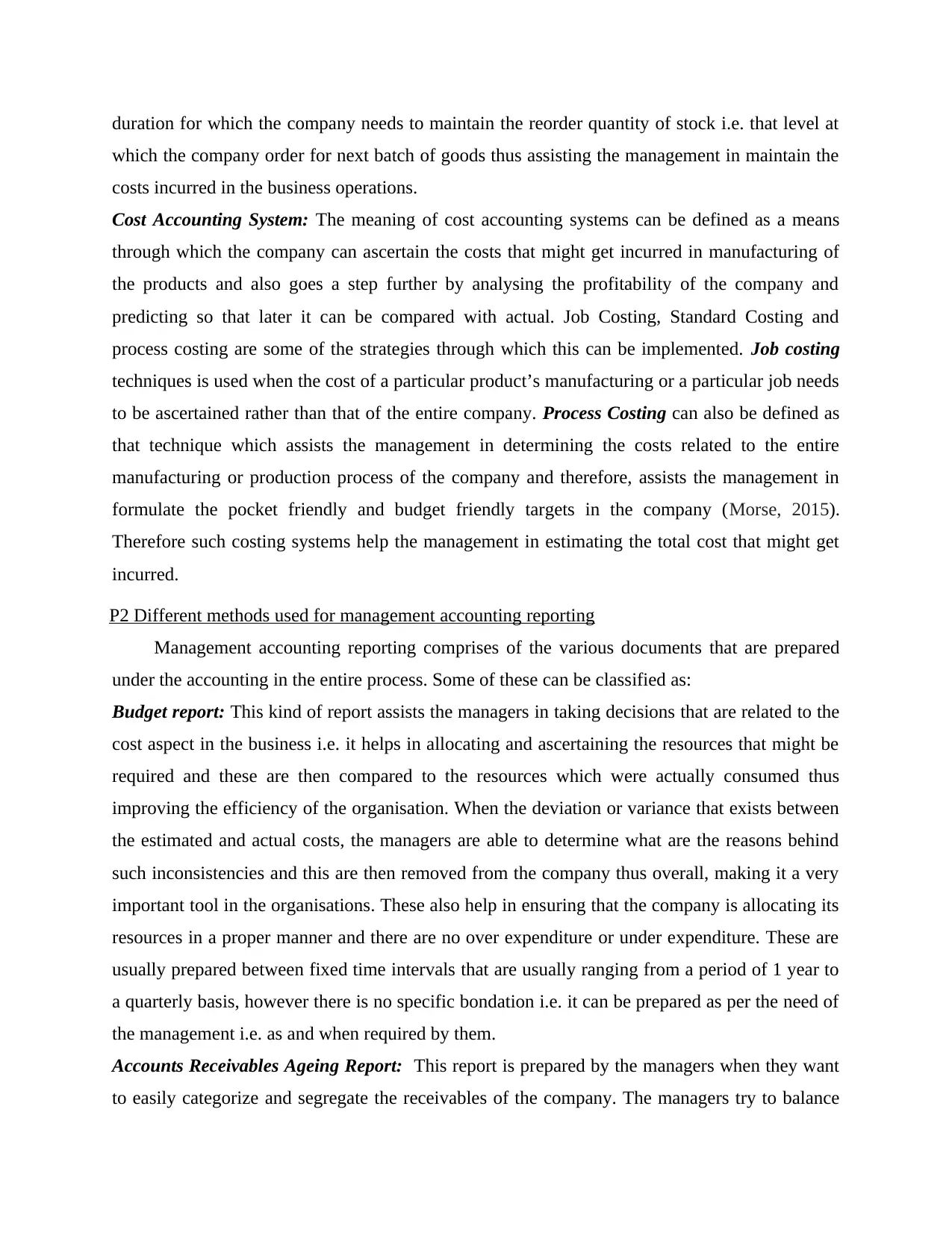
duration for which the company needs to maintain the reorder quantity of stock i.e. that level at
which the company order for next batch of goods thus assisting the management in maintain the
costs incurred in the business operations.
Cost Accounting System: The meaning of cost accounting systems can be defined as a means
through which the company can ascertain the costs that might get incurred in manufacturing of
the products and also goes a step further by analysing the profitability of the company and
predicting so that later it can be compared with actual. Job Costing, Standard Costing and
process costing are some of the strategies through which this can be implemented. Job costing
techniques is used when the cost of a particular product’s manufacturing or a particular job needs
to be ascertained rather than that of the entire company. Process Costing can also be defined as
that technique which assists the management in determining the costs related to the entire
manufacturing or production process of the company and therefore, assists the management in
formulate the pocket friendly and budget friendly targets in the company (Morse, 2015).
Therefore such costing systems help the management in estimating the total cost that might get
incurred.
P2 Different methods used for management accounting reporting
Management accounting reporting comprises of the various documents that are prepared
under the accounting in the entire process. Some of these can be classified as:
Budget report: This kind of report assists the managers in taking decisions that are related to the
cost aspect in the business i.e. it helps in allocating and ascertaining the resources that might be
required and these are then compared to the resources which were actually consumed thus
improving the efficiency of the organisation. When the deviation or variance that exists between
the estimated and actual costs, the managers are able to determine what are the reasons behind
such inconsistencies and this are then removed from the company thus overall, making it a very
important tool in the organisations. These also help in ensuring that the company is allocating its
resources in a proper manner and there are no over expenditure or under expenditure. These are
usually prepared between fixed time intervals that are usually ranging from a period of 1 year to
a quarterly basis, however there is no specific bondation i.e. it can be prepared as per the need of
the management i.e. as and when required by them.
Accounts Receivables Ageing Report: This report is prepared by the managers when they want
to easily categorize and segregate the receivables of the company. The managers try to balance
which the company order for next batch of goods thus assisting the management in maintain the
costs incurred in the business operations.
Cost Accounting System: The meaning of cost accounting systems can be defined as a means
through which the company can ascertain the costs that might get incurred in manufacturing of
the products and also goes a step further by analysing the profitability of the company and
predicting so that later it can be compared with actual. Job Costing, Standard Costing and
process costing are some of the strategies through which this can be implemented. Job costing
techniques is used when the cost of a particular product’s manufacturing or a particular job needs
to be ascertained rather than that of the entire company. Process Costing can also be defined as
that technique which assists the management in determining the costs related to the entire
manufacturing or production process of the company and therefore, assists the management in
formulate the pocket friendly and budget friendly targets in the company (Morse, 2015).
Therefore such costing systems help the management in estimating the total cost that might get
incurred.
P2 Different methods used for management accounting reporting
Management accounting reporting comprises of the various documents that are prepared
under the accounting in the entire process. Some of these can be classified as:
Budget report: This kind of report assists the managers in taking decisions that are related to the
cost aspect in the business i.e. it helps in allocating and ascertaining the resources that might be
required and these are then compared to the resources which were actually consumed thus
improving the efficiency of the organisation. When the deviation or variance that exists between
the estimated and actual costs, the managers are able to determine what are the reasons behind
such inconsistencies and this are then removed from the company thus overall, making it a very
important tool in the organisations. These also help in ensuring that the company is allocating its
resources in a proper manner and there are no over expenditure or under expenditure. These are
usually prepared between fixed time intervals that are usually ranging from a period of 1 year to
a quarterly basis, however there is no specific bondation i.e. it can be prepared as per the need of
the management i.e. as and when required by them.
Accounts Receivables Ageing Report: This report is prepared by the managers when they want
to easily categorize and segregate the receivables of the company. The managers try to balance
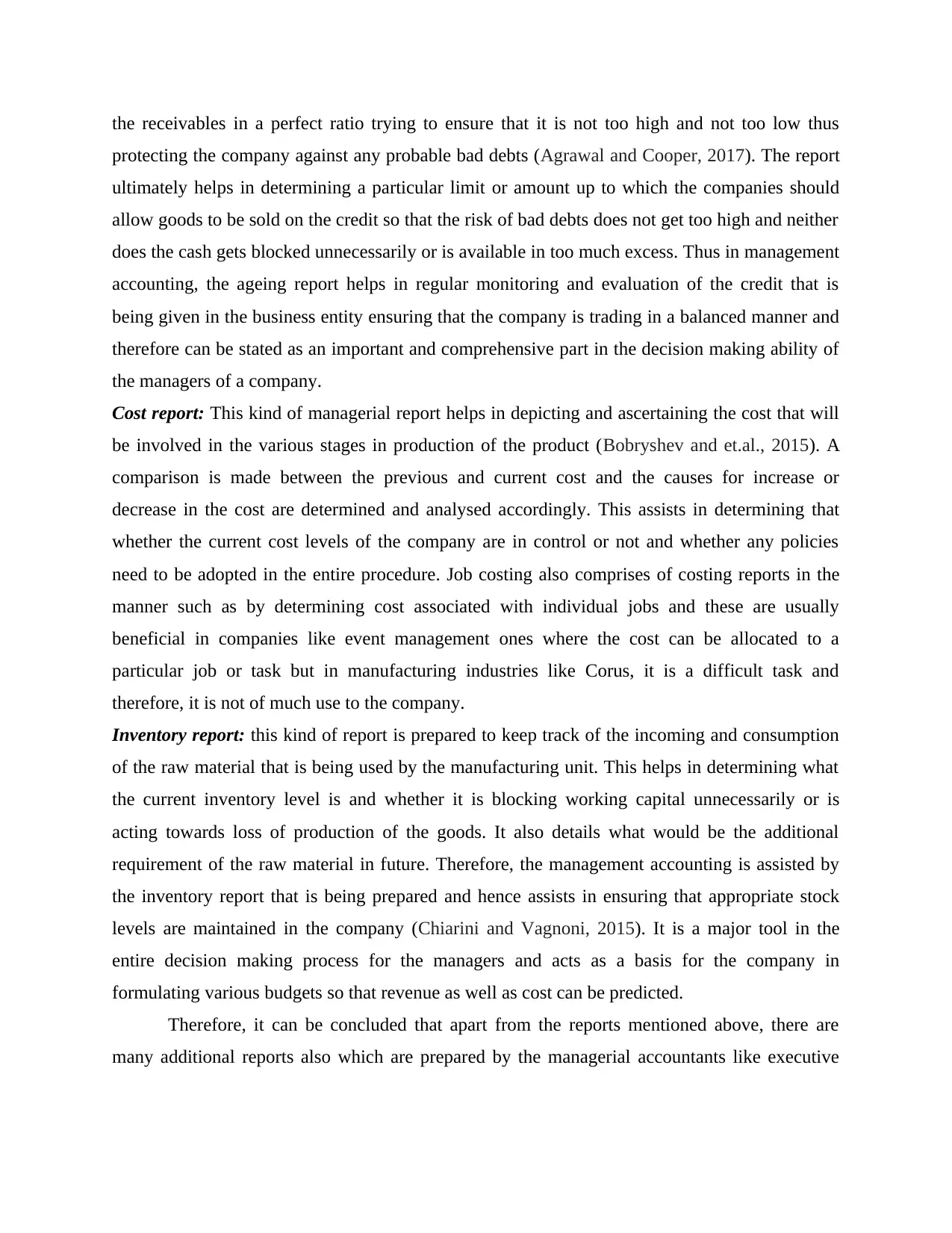
the receivables in a perfect ratio trying to ensure that it is not too high and not too low thus
protecting the company against any probable bad debts (Agrawal and Cooper, 2017). The report
ultimately helps in determining a particular limit or amount up to which the companies should
allow goods to be sold on the credit so that the risk of bad debts does not get too high and neither
does the cash gets blocked unnecessarily or is available in too much excess. Thus in management
accounting, the ageing report helps in regular monitoring and evaluation of the credit that is
being given in the business entity ensuring that the company is trading in a balanced manner and
therefore can be stated as an important and comprehensive part in the decision making ability of
the managers of a company.
Cost report: This kind of managerial report helps in depicting and ascertaining the cost that will
be involved in the various stages in production of the product (Bobryshev and et.al., 2015). A
comparison is made between the previous and current cost and the causes for increase or
decrease in the cost are determined and analysed accordingly. This assists in determining that
whether the current cost levels of the company are in control or not and whether any policies
need to be adopted in the entire procedure. Job costing also comprises of costing reports in the
manner such as by determining cost associated with individual jobs and these are usually
beneficial in companies like event management ones where the cost can be allocated to a
particular job or task but in manufacturing industries like Corus, it is a difficult task and
therefore, it is not of much use to the company.
Inventory report: this kind of report is prepared to keep track of the incoming and consumption
of the raw material that is being used by the manufacturing unit. This helps in determining what
the current inventory level is and whether it is blocking working capital unnecessarily or is
acting towards loss of production of the goods. It also details what would be the additional
requirement of the raw material in future. Therefore, the management accounting is assisted by
the inventory report that is being prepared and hence assists in ensuring that appropriate stock
levels are maintained in the company (Chiarini and Vagnoni, 2015). It is a major tool in the
entire decision making process for the managers and acts as a basis for the company in
formulating various budgets so that revenue as well as cost can be predicted.
Therefore, it can be concluded that apart from the reports mentioned above, there are
many additional reports also which are prepared by the managerial accountants like executive
protecting the company against any probable bad debts (Agrawal and Cooper, 2017). The report
ultimately helps in determining a particular limit or amount up to which the companies should
allow goods to be sold on the credit so that the risk of bad debts does not get too high and neither
does the cash gets blocked unnecessarily or is available in too much excess. Thus in management
accounting, the ageing report helps in regular monitoring and evaluation of the credit that is
being given in the business entity ensuring that the company is trading in a balanced manner and
therefore can be stated as an important and comprehensive part in the decision making ability of
the managers of a company.
Cost report: This kind of managerial report helps in depicting and ascertaining the cost that will
be involved in the various stages in production of the product (Bobryshev and et.al., 2015). A
comparison is made between the previous and current cost and the causes for increase or
decrease in the cost are determined and analysed accordingly. This assists in determining that
whether the current cost levels of the company are in control or not and whether any policies
need to be adopted in the entire procedure. Job costing also comprises of costing reports in the
manner such as by determining cost associated with individual jobs and these are usually
beneficial in companies like event management ones where the cost can be allocated to a
particular job or task but in manufacturing industries like Corus, it is a difficult task and
therefore, it is not of much use to the company.
Inventory report: this kind of report is prepared to keep track of the incoming and consumption
of the raw material that is being used by the manufacturing unit. This helps in determining what
the current inventory level is and whether it is blocking working capital unnecessarily or is
acting towards loss of production of the goods. It also details what would be the additional
requirement of the raw material in future. Therefore, the management accounting is assisted by
the inventory report that is being prepared and hence assists in ensuring that appropriate stock
levels are maintained in the company (Chiarini and Vagnoni, 2015). It is a major tool in the
entire decision making process for the managers and acts as a basis for the company in
formulating various budgets so that revenue as well as cost can be predicted.
Therefore, it can be concluded that apart from the reports mentioned above, there are
many additional reports also which are prepared by the managerial accountants like executive
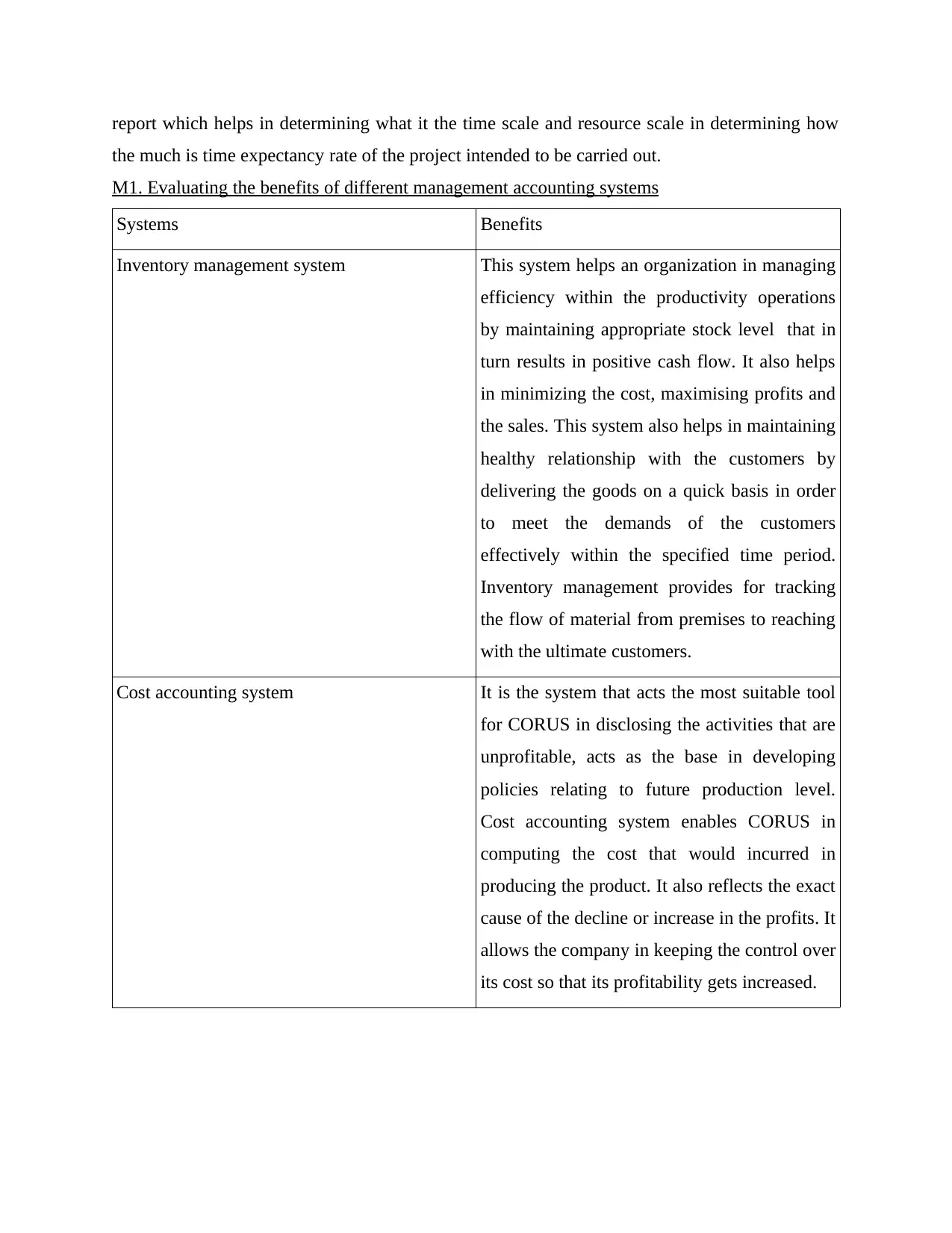
report which helps in determining what it the time scale and resource scale in determining how
the much is time expectancy rate of the project intended to be carried out.
M1. Evaluating the benefits of different management accounting systems
Systems Benefits
Inventory management system This system helps an organization in managing
efficiency within the productivity operations
by maintaining appropriate stock level that in
turn results in positive cash flow. It also helps
in minimizing the cost, maximising profits and
the sales. This system also helps in maintaining
healthy relationship with the customers by
delivering the goods on a quick basis in order
to meet the demands of the customers
effectively within the specified time period.
Inventory management provides for tracking
the flow of material from premises to reaching
with the ultimate customers.
Cost accounting system It is the system that acts the most suitable tool
for CORUS in disclosing the activities that are
unprofitable, acts as the base in developing
policies relating to future production level.
Cost accounting system enables CORUS in
computing the cost that would incurred in
producing the product. It also reflects the exact
cause of the decline or increase in the profits. It
allows the company in keeping the control over
its cost so that its profitability gets increased.
the much is time expectancy rate of the project intended to be carried out.
M1. Evaluating the benefits of different management accounting systems
Systems Benefits
Inventory management system This system helps an organization in managing
efficiency within the productivity operations
by maintaining appropriate stock level that in
turn results in positive cash flow. It also helps
in minimizing the cost, maximising profits and
the sales. This system also helps in maintaining
healthy relationship with the customers by
delivering the goods on a quick basis in order
to meet the demands of the customers
effectively within the specified time period.
Inventory management provides for tracking
the flow of material from premises to reaching
with the ultimate customers.
Cost accounting system It is the system that acts the most suitable tool
for CORUS in disclosing the activities that are
unprofitable, acts as the base in developing
policies relating to future production level.
Cost accounting system enables CORUS in
computing the cost that would incurred in
producing the product. It also reflects the exact
cause of the decline or increase in the profits. It
allows the company in keeping the control over
its cost so that its profitability gets increased.
Paraphrase This Document
Need a fresh take? Get an instant paraphrase of this document with our AI Paraphraser
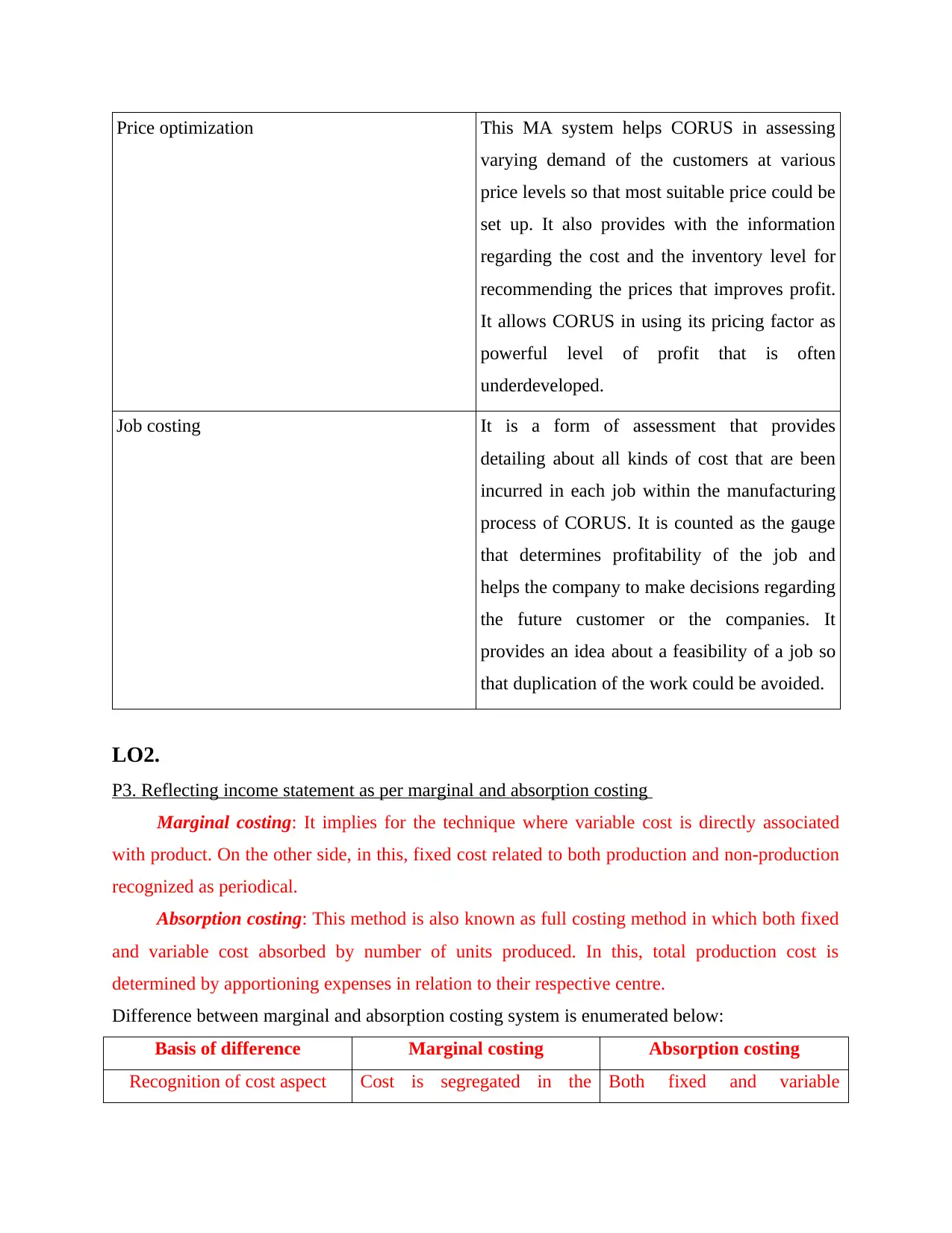
Price optimization This MA system helps CORUS in assessing
varying demand of the customers at various
price levels so that most suitable price could be
set up. It also provides with the information
regarding the cost and the inventory level for
recommending the prices that improves profit.
It allows CORUS in using its pricing factor as
powerful level of profit that is often
underdeveloped.
Job costing It is a form of assessment that provides
detailing about all kinds of cost that are been
incurred in each job within the manufacturing
process of CORUS. It is counted as the gauge
that determines profitability of the job and
helps the company to make decisions regarding
the future customer or the companies. It
provides an idea about a feasibility of a job so
that duplication of the work could be avoided.
LO2.
P3. Reflecting income statement as per marginal and absorption costing
Marginal costing: It implies for the technique where variable cost is directly associated
with product. On the other side, in this, fixed cost related to both production and non-production
recognized as periodical.
Absorption costing: This method is also known as full costing method in which both fixed
and variable cost absorbed by number of units produced. In this, total production cost is
determined by apportioning expenses in relation to their respective centre.
Difference between marginal and absorption costing system is enumerated below:
Basis of difference Marginal costing Absorption costing
Recognition of cost aspect Cost is segregated in the Both fixed and variable
varying demand of the customers at various
price levels so that most suitable price could be
set up. It also provides with the information
regarding the cost and the inventory level for
recommending the prices that improves profit.
It allows CORUS in using its pricing factor as
powerful level of profit that is often
underdeveloped.
Job costing It is a form of assessment that provides
detailing about all kinds of cost that are been
incurred in each job within the manufacturing
process of CORUS. It is counted as the gauge
that determines profitability of the job and
helps the company to make decisions regarding
the future customer or the companies. It
provides an idea about a feasibility of a job so
that duplication of the work could be avoided.
LO2.
P3. Reflecting income statement as per marginal and absorption costing
Marginal costing: It implies for the technique where variable cost is directly associated
with product. On the other side, in this, fixed cost related to both production and non-production
recognized as periodical.
Absorption costing: This method is also known as full costing method in which both fixed
and variable cost absorbed by number of units produced. In this, total production cost is
determined by apportioning expenses in relation to their respective centre.
Difference between marginal and absorption costing system is enumerated below:
Basis of difference Marginal costing Absorption costing
Recognition of cost aspect Cost is segregated in the Both fixed and variable
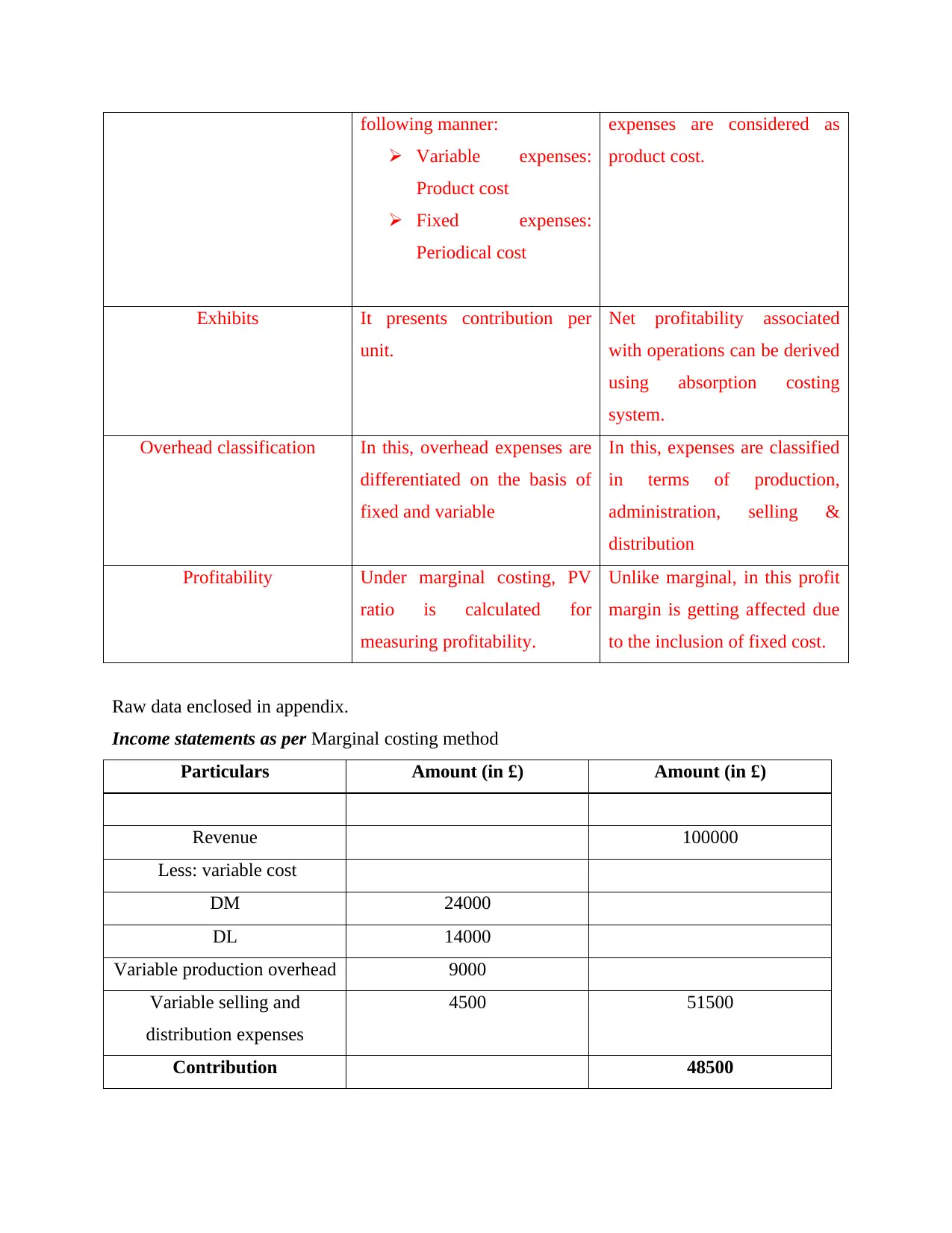
following manner:
Variable expenses:
Product cost
Fixed expenses:
Periodical cost
expenses are considered as
product cost.
Exhibits It presents contribution per
unit.
Net profitability associated
with operations can be derived
using absorption costing
system.
Overhead classification In this, overhead expenses are
differentiated on the basis of
fixed and variable
In this, expenses are classified
in terms of production,
administration, selling &
distribution
Profitability Under marginal costing, PV
ratio is calculated for
measuring profitability.
Unlike marginal, in this profit
margin is getting affected due
to the inclusion of fixed cost.
Raw data enclosed in appendix.
Income statements as per Marginal costing method
Particulars Amount (in £) Amount (in £)
Revenue 100000
Less: variable cost
DM 24000
DL 14000
Variable production overhead 9000
Variable selling and
distribution expenses
4500 51500
Contribution 48500
Variable expenses:
Product cost
Fixed expenses:
Periodical cost
expenses are considered as
product cost.
Exhibits It presents contribution per
unit.
Net profitability associated
with operations can be derived
using absorption costing
system.
Overhead classification In this, overhead expenses are
differentiated on the basis of
fixed and variable
In this, expenses are classified
in terms of production,
administration, selling &
distribution
Profitability Under marginal costing, PV
ratio is calculated for
measuring profitability.
Unlike marginal, in this profit
margin is getting affected due
to the inclusion of fixed cost.
Raw data enclosed in appendix.
Income statements as per Marginal costing method
Particulars Amount (in £) Amount (in £)
Revenue 100000
Less: variable cost
DM 24000
DL 14000
Variable production overhead 9000
Variable selling and
distribution expenses
4500 51500
Contribution 48500
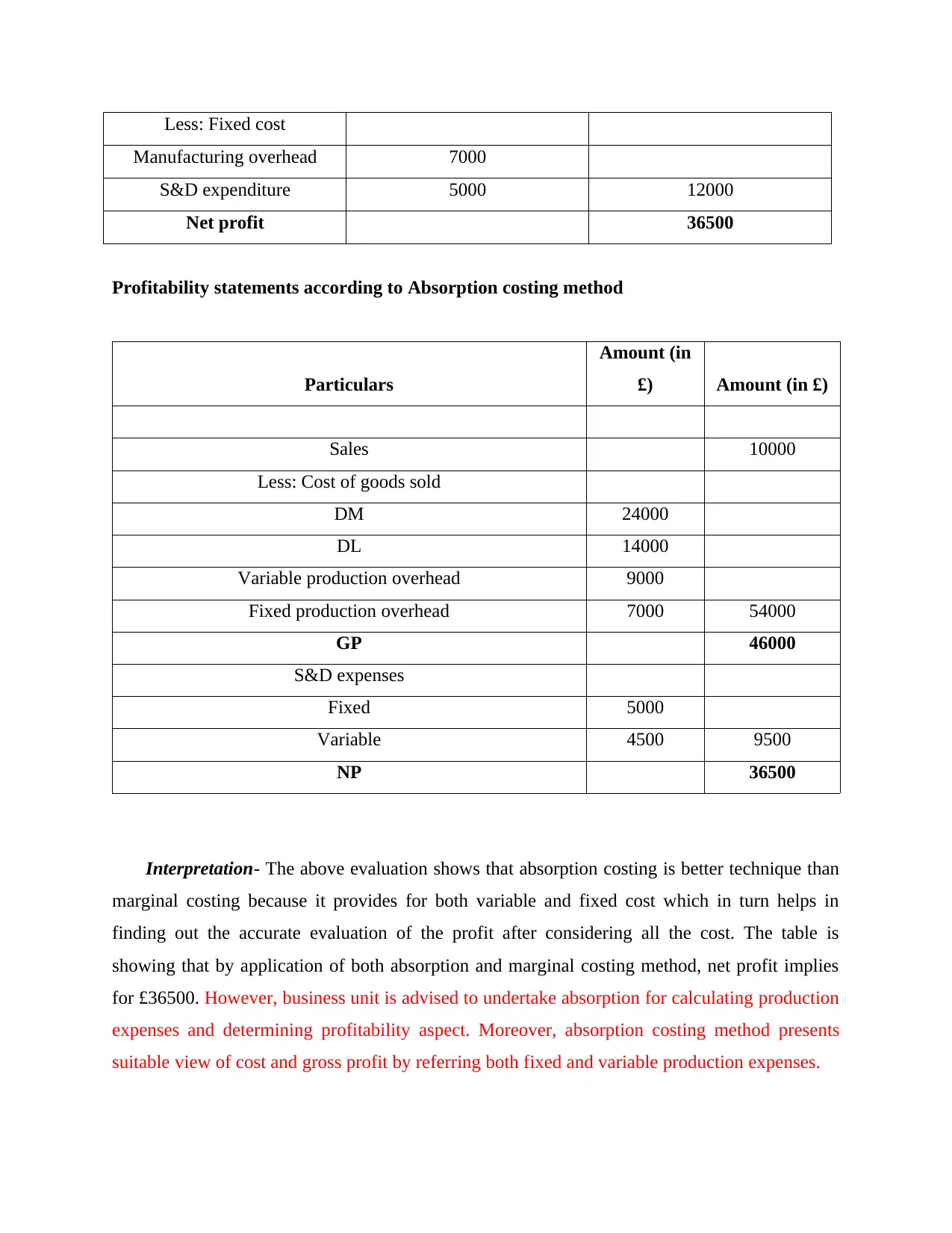
Less: Fixed cost
Manufacturing overhead 7000
S&D expenditure 5000 12000
Net profit 36500
Profitability statements according to Absorption costing method
Particulars
Amount (in
£) Amount (in £)
Sales 10000
Less: Cost of goods sold
DM 24000
DL 14000
Variable production overhead 9000
Fixed production overhead 7000 54000
GP 46000
S&D expenses
Fixed 5000
Variable 4500 9500
NP 36500
Interpretation- The above evaluation shows that absorption costing is better technique than
marginal costing because it provides for both variable and fixed cost which in turn helps in
finding out the accurate evaluation of the profit after considering all the cost. The table is
showing that by application of both absorption and marginal costing method, net profit implies
for £36500. However, business unit is advised to undertake absorption for calculating production
expenses and determining profitability aspect. Moreover, absorption costing method presents
suitable view of cost and gross profit by referring both fixed and variable production expenses.
Manufacturing overhead 7000
S&D expenditure 5000 12000
Net profit 36500
Profitability statements according to Absorption costing method
Particulars
Amount (in
£) Amount (in £)
Sales 10000
Less: Cost of goods sold
DM 24000
DL 14000
Variable production overhead 9000
Fixed production overhead 7000 54000
GP 46000
S&D expenses
Fixed 5000
Variable 4500 9500
NP 36500
Interpretation- The above evaluation shows that absorption costing is better technique than
marginal costing because it provides for both variable and fixed cost which in turn helps in
finding out the accurate evaluation of the profit after considering all the cost. The table is
showing that by application of both absorption and marginal costing method, net profit implies
for £36500. However, business unit is advised to undertake absorption for calculating production
expenses and determining profitability aspect. Moreover, absorption costing method presents
suitable view of cost and gross profit by referring both fixed and variable production expenses.
Secure Best Marks with AI Grader
Need help grading? Try our AI Grader for instant feedback on your assignments.
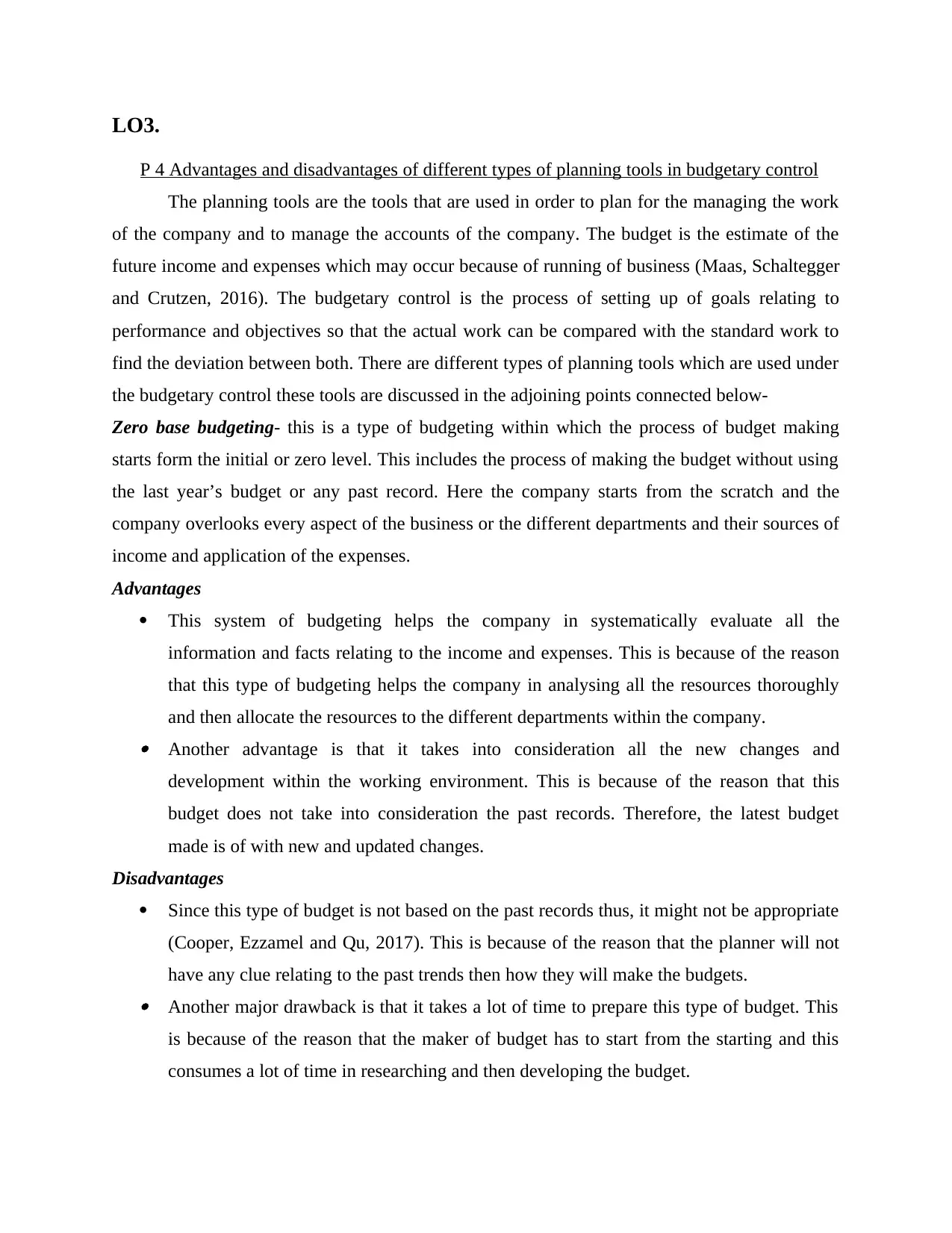
LO3.
P 4 Advantages and disadvantages of different types of planning tools in budgetary control
The planning tools are the tools that are used in order to plan for the managing the work
of the company and to manage the accounts of the company. The budget is the estimate of the
future income and expenses which may occur because of running of business (Maas, Schaltegger
and Crutzen, 2016). The budgetary control is the process of setting up of goals relating to
performance and objectives so that the actual work can be compared with the standard work to
find the deviation between both. There are different types of planning tools which are used under
the budgetary control these tools are discussed in the adjoining points connected below-
Zero base budgeting- this is a type of budgeting within which the process of budget making
starts form the initial or zero level. This includes the process of making the budget without using
the last year’s budget or any past record. Here the company starts from the scratch and the
company overlooks every aspect of the business or the different departments and their sources of
income and application of the expenses.
Advantages
This system of budgeting helps the company in systematically evaluate all the
information and facts relating to the income and expenses. This is because of the reason
that this type of budgeting helps the company in analysing all the resources thoroughly
and then allocate the resources to the different departments within the company. Another advantage is that it takes into consideration all the new changes and
development within the working environment. This is because of the reason that this
budget does not take into consideration the past records. Therefore, the latest budget
made is of with new and updated changes.
Disadvantages
Since this type of budget is not based on the past records thus, it might not be appropriate
(Cooper, Ezzamel and Qu, 2017). This is because of the reason that the planner will not
have any clue relating to the past trends then how they will make the budgets. Another major drawback is that it takes a lot of time to prepare this type of budget. This
is because of the reason that the maker of budget has to start from the starting and this
consumes a lot of time in researching and then developing the budget.
P 4 Advantages and disadvantages of different types of planning tools in budgetary control
The planning tools are the tools that are used in order to plan for the managing the work
of the company and to manage the accounts of the company. The budget is the estimate of the
future income and expenses which may occur because of running of business (Maas, Schaltegger
and Crutzen, 2016). The budgetary control is the process of setting up of goals relating to
performance and objectives so that the actual work can be compared with the standard work to
find the deviation between both. There are different types of planning tools which are used under
the budgetary control these tools are discussed in the adjoining points connected below-
Zero base budgeting- this is a type of budgeting within which the process of budget making
starts form the initial or zero level. This includes the process of making the budget without using
the last year’s budget or any past record. Here the company starts from the scratch and the
company overlooks every aspect of the business or the different departments and their sources of
income and application of the expenses.
Advantages
This system of budgeting helps the company in systematically evaluate all the
information and facts relating to the income and expenses. This is because of the reason
that this type of budgeting helps the company in analysing all the resources thoroughly
and then allocate the resources to the different departments within the company. Another advantage is that it takes into consideration all the new changes and
development within the working environment. This is because of the reason that this
budget does not take into consideration the past records. Therefore, the latest budget
made is of with new and updated changes.
Disadvantages
Since this type of budget is not based on the past records thus, it might not be appropriate
(Cooper, Ezzamel and Qu, 2017). This is because of the reason that the planner will not
have any clue relating to the past trends then how they will make the budgets. Another major drawback is that it takes a lot of time to prepare this type of budget. This
is because of the reason that the maker of budget has to start from the starting and this
consumes a lot of time in researching and then developing the budget.
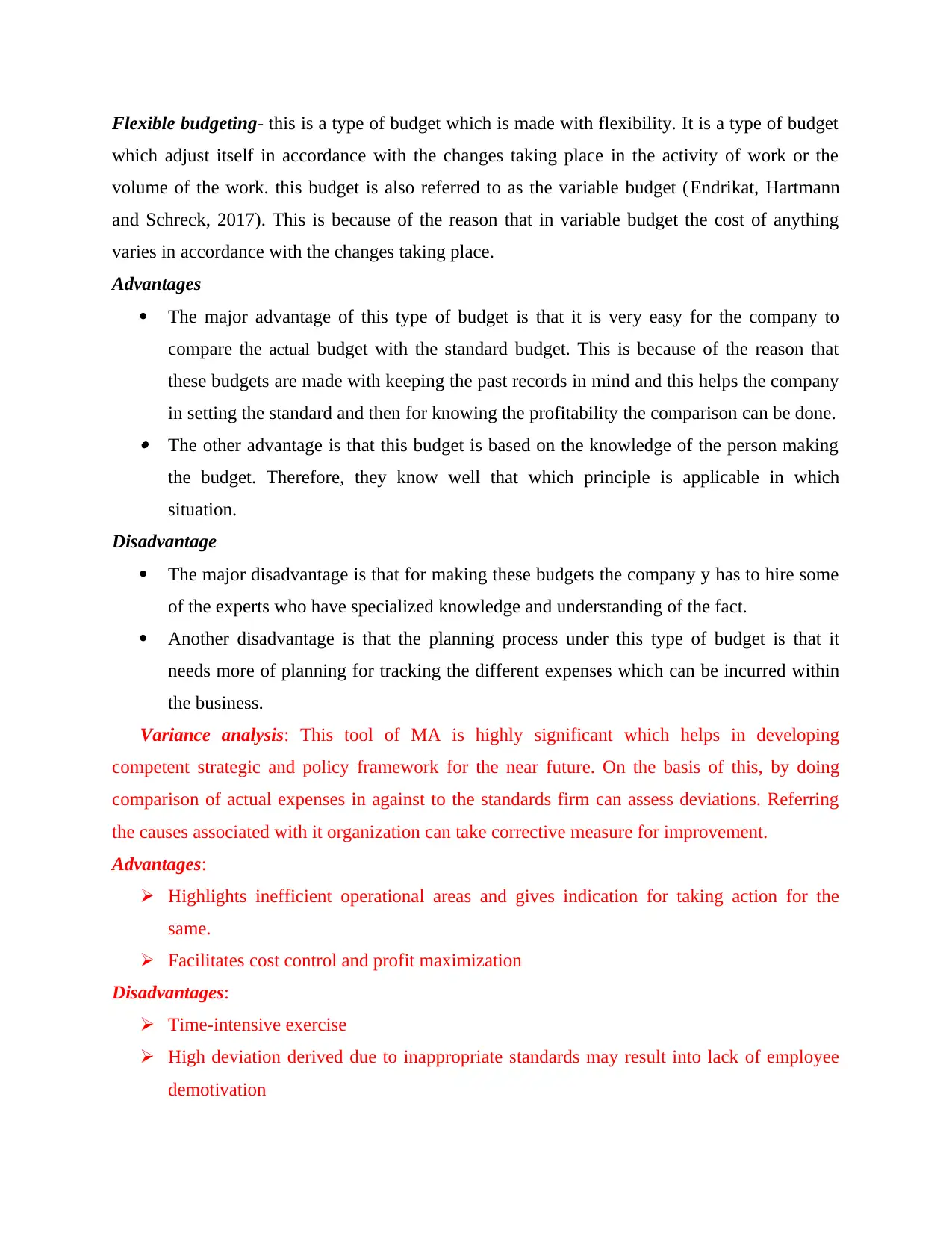
Flexible budgeting- this is a type of budget which is made with flexibility. It is a type of budget
which adjust itself in accordance with the changes taking place in the activity of work or the
volume of the work. this budget is also referred to as the variable budget (Endrikat, Hartmann
and Schreck, 2017). This is because of the reason that in variable budget the cost of anything
varies in accordance with the changes taking place.
Advantages
The major advantage of this type of budget is that it is very easy for the company to
compare the actual budget with the standard budget. This is because of the reason that
these budgets are made with keeping the past records in mind and this helps the company
in setting the standard and then for knowing the profitability the comparison can be done. The other advantage is that this budget is based on the knowledge of the person making
the budget. Therefore, they know well that which principle is applicable in which
situation.
Disadvantage
The major disadvantage is that for making these budgets the company y has to hire some
of the experts who have specialized knowledge and understanding of the fact.
Another disadvantage is that the planning process under this type of budget is that it
needs more of planning for tracking the different expenses which can be incurred within
the business.
Variance analysis: This tool of MA is highly significant which helps in developing
competent strategic and policy framework for the near future. On the basis of this, by doing
comparison of actual expenses in against to the standards firm can assess deviations. Referring
the causes associated with it organization can take corrective measure for improvement.
Advantages:
Highlights inefficient operational areas and gives indication for taking action for the
same.
Facilitates cost control and profit maximization
Disadvantages:
Time-intensive exercise
High deviation derived due to inappropriate standards may result into lack of employee
demotivation
which adjust itself in accordance with the changes taking place in the activity of work or the
volume of the work. this budget is also referred to as the variable budget (Endrikat, Hartmann
and Schreck, 2017). This is because of the reason that in variable budget the cost of anything
varies in accordance with the changes taking place.
Advantages
The major advantage of this type of budget is that it is very easy for the company to
compare the actual budget with the standard budget. This is because of the reason that
these budgets are made with keeping the past records in mind and this helps the company
in setting the standard and then for knowing the profitability the comparison can be done. The other advantage is that this budget is based on the knowledge of the person making
the budget. Therefore, they know well that which principle is applicable in which
situation.
Disadvantage
The major disadvantage is that for making these budgets the company y has to hire some
of the experts who have specialized knowledge and understanding of the fact.
Another disadvantage is that the planning process under this type of budget is that it
needs more of planning for tracking the different expenses which can be incurred within
the business.
Variance analysis: This tool of MA is highly significant which helps in developing
competent strategic and policy framework for the near future. On the basis of this, by doing
comparison of actual expenses in against to the standards firm can assess deviations. Referring
the causes associated with it organization can take corrective measure for improvement.
Advantages:
Highlights inefficient operational areas and gives indication for taking action for the
same.
Facilitates cost control and profit maximization
Disadvantages:
Time-intensive exercise
High deviation derived due to inappropriate standards may result into lack of employee
demotivation
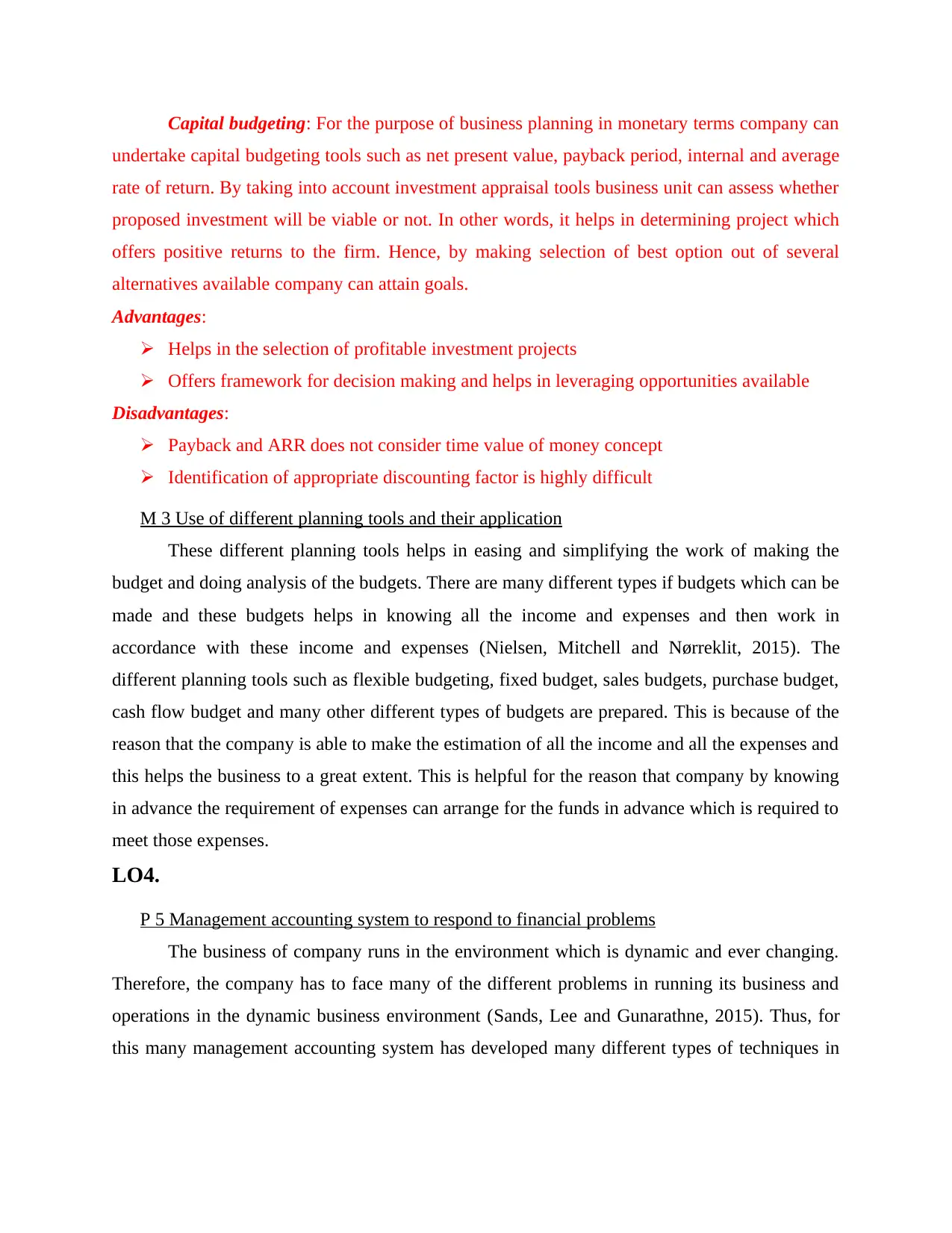
Capital budgeting: For the purpose of business planning in monetary terms company can
undertake capital budgeting tools such as net present value, payback period, internal and average
rate of return. By taking into account investment appraisal tools business unit can assess whether
proposed investment will be viable or not. In other words, it helps in determining project which
offers positive returns to the firm. Hence, by making selection of best option out of several
alternatives available company can attain goals.
Advantages:
Helps in the selection of profitable investment projects
Offers framework for decision making and helps in leveraging opportunities available
Disadvantages:
Payback and ARR does not consider time value of money concept
Identification of appropriate discounting factor is highly difficult
M 3 Use of different planning tools and their application
These different planning tools helps in easing and simplifying the work of making the
budget and doing analysis of the budgets. There are many different types if budgets which can be
made and these budgets helps in knowing all the income and expenses and then work in
accordance with these income and expenses (Nielsen, Mitchell and Nørreklit, 2015). The
different planning tools such as flexible budgeting, fixed budget, sales budgets, purchase budget,
cash flow budget and many other different types of budgets are prepared. This is because of the
reason that the company is able to make the estimation of all the income and all the expenses and
this helps the business to a great extent. This is helpful for the reason that company by knowing
in advance the requirement of expenses can arrange for the funds in advance which is required to
meet those expenses.
LO4.
P 5 Management accounting system to respond to financial problems
The business of company runs in the environment which is dynamic and ever changing.
Therefore, the company has to face many of the different problems in running its business and
operations in the dynamic business environment (Sands, Lee and Gunarathne, 2015). Thus, for
this many management accounting system has developed many different types of techniques in
undertake capital budgeting tools such as net present value, payback period, internal and average
rate of return. By taking into account investment appraisal tools business unit can assess whether
proposed investment will be viable or not. In other words, it helps in determining project which
offers positive returns to the firm. Hence, by making selection of best option out of several
alternatives available company can attain goals.
Advantages:
Helps in the selection of profitable investment projects
Offers framework for decision making and helps in leveraging opportunities available
Disadvantages:
Payback and ARR does not consider time value of money concept
Identification of appropriate discounting factor is highly difficult
M 3 Use of different planning tools and their application
These different planning tools helps in easing and simplifying the work of making the
budget and doing analysis of the budgets. There are many different types if budgets which can be
made and these budgets helps in knowing all the income and expenses and then work in
accordance with these income and expenses (Nielsen, Mitchell and Nørreklit, 2015). The
different planning tools such as flexible budgeting, fixed budget, sales budgets, purchase budget,
cash flow budget and many other different types of budgets are prepared. This is because of the
reason that the company is able to make the estimation of all the income and all the expenses and
this helps the business to a great extent. This is helpful for the reason that company by knowing
in advance the requirement of expenses can arrange for the funds in advance which is required to
meet those expenses.
LO4.
P 5 Management accounting system to respond to financial problems
The business of company runs in the environment which is dynamic and ever changing.
Therefore, the company has to face many of the different problems in running its business and
operations in the dynamic business environment (Sands, Lee and Gunarathne, 2015). Thus, for
this many management accounting system has developed many different types of techniques in
Paraphrase This Document
Need a fresh take? Get an instant paraphrase of this document with our AI Paraphraser

order to solve these problems faced by the company. These tools and techniques used to solve
the problems are discussed in the adjoining points connected below-
Benchmarking- this is the management accounting system which the company uses in
order to meet the objectives and to remove the problems of the business. The benchmarking is a
technique in which the company compares its business with that of the competitors in the same
industry. This is done because of the reason that the in comparison with the competitor the
company can know its point of strength and weaknesses and this helps the company in
overcoming them.
Corus is a company which finds difficult in analysing the fact that whether the money
borrowed from bank is at good interest rate. Therefore, the company here uses the technique of
benchmarking. This is because of the reason that in comparison with the competitor the company
can know about the interest rate which the other company is paying to the bank.
But in contrast to this Posco which is also a manufacturing company uses benchmarking
in order to know the competitive position of the company into the market. This is because of the
reason that with the help of benchmarking the company comes to know its competitive position.
Key performance indicator- this is yet another management accounting system which
helps in analysing the different aspects of the business. Under this technique the company sets a
measure or standard keeping in mind the objectives and goals of the business so that the actual
performance can be measured and if there are any deviation then it can be solved. These
indicators can be like revenue, growth rate, profit rates, working capital and many other similar
options (Soderstrom, Soderstrom and Stewart, 2017). These indicators are used as standards like
the last year’s revenue is set as key performance indicator that the company has to at least earn
that much of revenue.
Corus uses this management accounting system in setting standard for the growth of the
company. This is majorly because of the reason that this system sets a standard and if the
standards are not met and deviations are there then corrective actions are taken in order to
increase the sales of the company (Lopez-Valeiras, Gomez-Conde and Naranjo-Gil, 2015). But
in contrast to this Posco uses this technique of key performance indicator in order to not the
deviation of revenue as compared with the last year. This is majorly because of the reason that
this setting up of indicator helps the company in analysing the last year performance and if the
current performance is better than the last year then there is no problem. But if the current year
the problems are discussed in the adjoining points connected below-
Benchmarking- this is the management accounting system which the company uses in
order to meet the objectives and to remove the problems of the business. The benchmarking is a
technique in which the company compares its business with that of the competitors in the same
industry. This is done because of the reason that the in comparison with the competitor the
company can know its point of strength and weaknesses and this helps the company in
overcoming them.
Corus is a company which finds difficult in analysing the fact that whether the money
borrowed from bank is at good interest rate. Therefore, the company here uses the technique of
benchmarking. This is because of the reason that in comparison with the competitor the company
can know about the interest rate which the other company is paying to the bank.
But in contrast to this Posco which is also a manufacturing company uses benchmarking
in order to know the competitive position of the company into the market. This is because of the
reason that with the help of benchmarking the company comes to know its competitive position.
Key performance indicator- this is yet another management accounting system which
helps in analysing the different aspects of the business. Under this technique the company sets a
measure or standard keeping in mind the objectives and goals of the business so that the actual
performance can be measured and if there are any deviation then it can be solved. These
indicators can be like revenue, growth rate, profit rates, working capital and many other similar
options (Soderstrom, Soderstrom and Stewart, 2017). These indicators are used as standards like
the last year’s revenue is set as key performance indicator that the company has to at least earn
that much of revenue.
Corus uses this management accounting system in setting standard for the growth of the
company. This is majorly because of the reason that this system sets a standard and if the
standards are not met and deviations are there then corrective actions are taken in order to
increase the sales of the company (Lopez-Valeiras, Gomez-Conde and Naranjo-Gil, 2015). But
in contrast to this Posco uses this technique of key performance indicator in order to not the
deviation of revenue as compared with the last year. This is majorly because of the reason that
this setting up of indicator helps the company in analysing the last year performance and if the
current performance is better than the last year then there is no problem. But if the current year
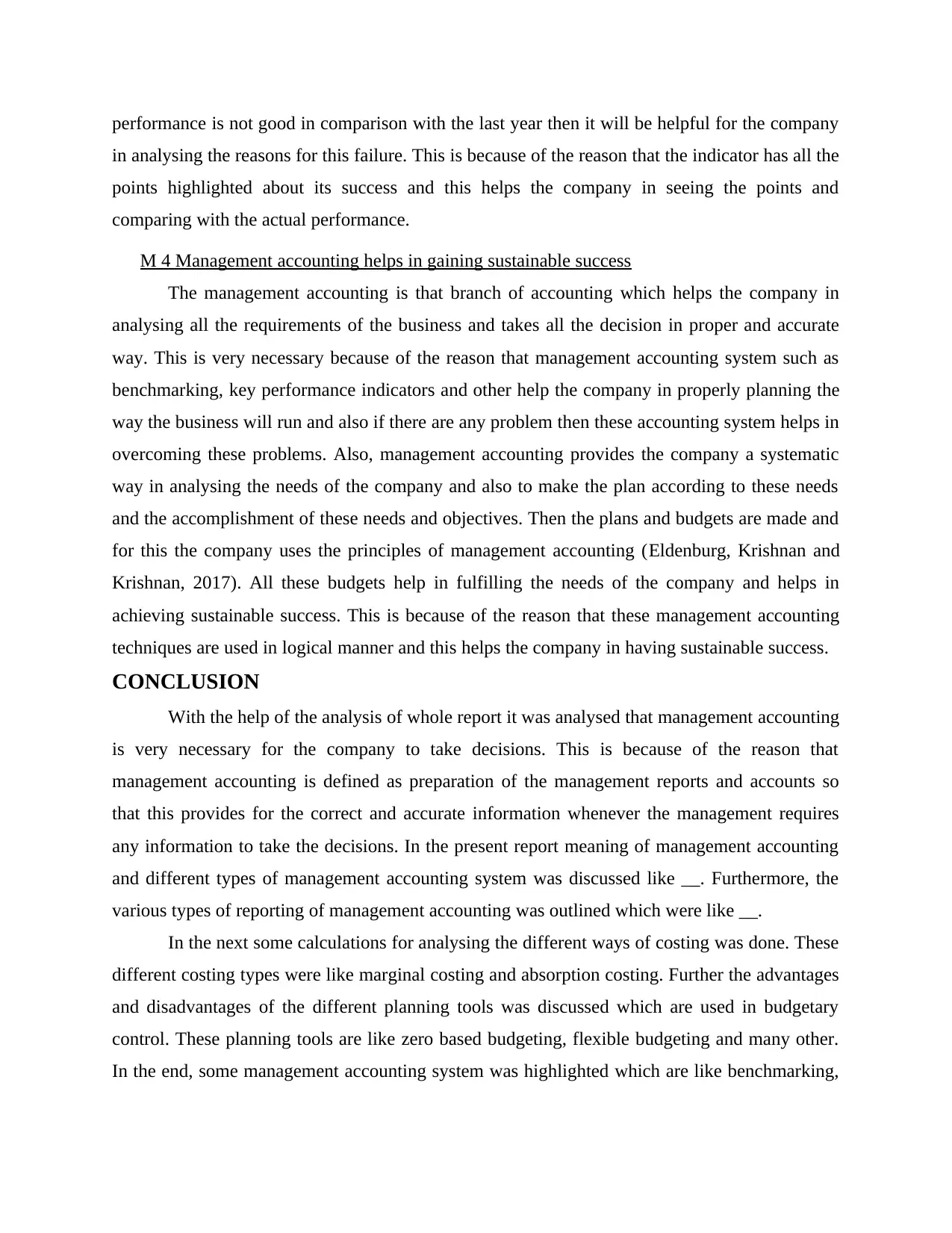
performance is not good in comparison with the last year then it will be helpful for the company
in analysing the reasons for this failure. This is because of the reason that the indicator has all the
points highlighted about its success and this helps the company in seeing the points and
comparing with the actual performance.
M 4 Management accounting helps in gaining sustainable success
The management accounting is that branch of accounting which helps the company in
analysing all the requirements of the business and takes all the decision in proper and accurate
way. This is very necessary because of the reason that management accounting system such as
benchmarking, key performance indicators and other help the company in properly planning the
way the business will run and also if there are any problem then these accounting system helps in
overcoming these problems. Also, management accounting provides the company a systematic
way in analysing the needs of the company and also to make the plan according to these needs
and the accomplishment of these needs and objectives. Then the plans and budgets are made and
for this the company uses the principles of management accounting (Eldenburg, Krishnan and
Krishnan, 2017). All these budgets help in fulfilling the needs of the company and helps in
achieving sustainable success. This is because of the reason that these management accounting
techniques are used in logical manner and this helps the company in having sustainable success.
CONCLUSION
With the help of the analysis of whole report it was analysed that management accounting
is very necessary for the company to take decisions. This is because of the reason that
management accounting is defined as preparation of the management reports and accounts so
that this provides for the correct and accurate information whenever the management requires
any information to take the decisions. In the present report meaning of management accounting
and different types of management accounting system was discussed like __. Furthermore, the
various types of reporting of management accounting was outlined which were like __.
In the next some calculations for analysing the different ways of costing was done. These
different costing types were like marginal costing and absorption costing. Further the advantages
and disadvantages of the different planning tools was discussed which are used in budgetary
control. These planning tools are like zero based budgeting, flexible budgeting and many other.
In the end, some management accounting system was highlighted which are like benchmarking,
in analysing the reasons for this failure. This is because of the reason that the indicator has all the
points highlighted about its success and this helps the company in seeing the points and
comparing with the actual performance.
M 4 Management accounting helps in gaining sustainable success
The management accounting is that branch of accounting which helps the company in
analysing all the requirements of the business and takes all the decision in proper and accurate
way. This is very necessary because of the reason that management accounting system such as
benchmarking, key performance indicators and other help the company in properly planning the
way the business will run and also if there are any problem then these accounting system helps in
overcoming these problems. Also, management accounting provides the company a systematic
way in analysing the needs of the company and also to make the plan according to these needs
and the accomplishment of these needs and objectives. Then the plans and budgets are made and
for this the company uses the principles of management accounting (Eldenburg, Krishnan and
Krishnan, 2017). All these budgets help in fulfilling the needs of the company and helps in
achieving sustainable success. This is because of the reason that these management accounting
techniques are used in logical manner and this helps the company in having sustainable success.
CONCLUSION
With the help of the analysis of whole report it was analysed that management accounting
is very necessary for the company to take decisions. This is because of the reason that
management accounting is defined as preparation of the management reports and accounts so
that this provides for the correct and accurate information whenever the management requires
any information to take the decisions. In the present report meaning of management accounting
and different types of management accounting system was discussed like __. Furthermore, the
various types of reporting of management accounting was outlined which were like __.
In the next some calculations for analysing the different ways of costing was done. These
different costing types were like marginal costing and absorption costing. Further the advantages
and disadvantages of the different planning tools was discussed which are used in budgetary
control. These planning tools are like zero based budgeting, flexible budgeting and many other.
In the end, some management accounting system was highlighted which are like benchmarking,
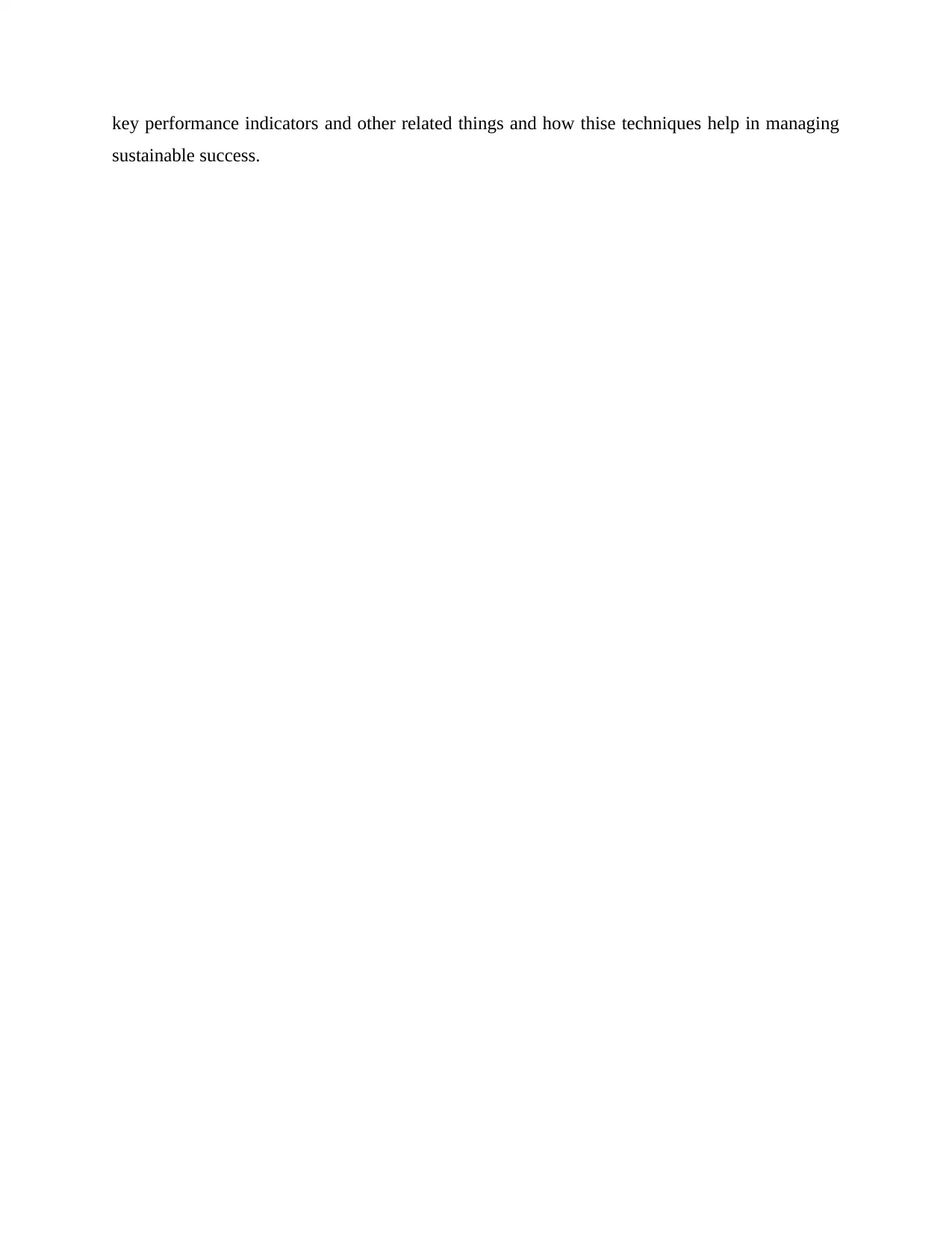
key performance indicators and other related things and how thise techniques help in managing
sustainable success.
sustainable success.
Secure Best Marks with AI Grader
Need help grading? Try our AI Grader for instant feedback on your assignments.
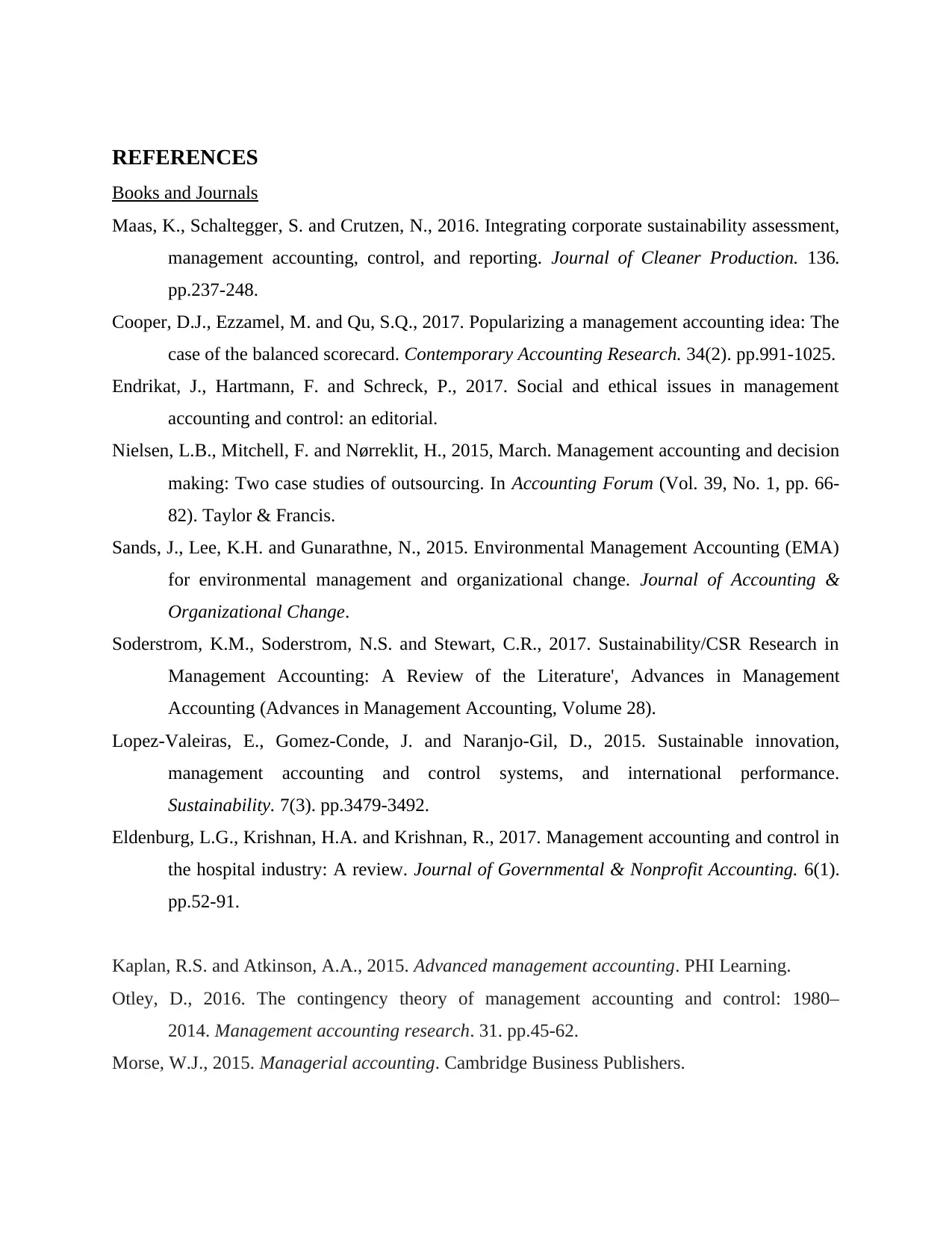
REFERENCES
Books and Journals
Maas, K., Schaltegger, S. and Crutzen, N., 2016. Integrating corporate sustainability assessment,
management accounting, control, and reporting. Journal of Cleaner Production. 136.
pp.237-248.
Cooper, D.J., Ezzamel, M. and Qu, S.Q., 2017. Popularizing a management accounting idea: The
case of the balanced scorecard. Contemporary Accounting Research. 34(2). pp.991-1025.
Endrikat, J., Hartmann, F. and Schreck, P., 2017. Social and ethical issues in management
accounting and control: an editorial.
Nielsen, L.B., Mitchell, F. and Nørreklit, H., 2015, March. Management accounting and decision
making: Two case studies of outsourcing. In Accounting Forum (Vol. 39, No. 1, pp. 66-
82). Taylor & Francis.
Sands, J., Lee, K.H. and Gunarathne, N., 2015. Environmental Management Accounting (EMA)
for environmental management and organizational change. Journal of Accounting &
Organizational Change.
Soderstrom, K.M., Soderstrom, N.S. and Stewart, C.R., 2017. Sustainability/CSR Research in
Management Accounting: A Review of the Literature', Advances in Management
Accounting (Advances in Management Accounting, Volume 28).
Lopez-Valeiras, E., Gomez-Conde, J. and Naranjo-Gil, D., 2015. Sustainable innovation,
management accounting and control systems, and international performance.
Sustainability. 7(3). pp.3479-3492.
Eldenburg, L.G., Krishnan, H.A. and Krishnan, R., 2017. Management accounting and control in
the hospital industry: A review. Journal of Governmental & Nonprofit Accounting. 6(1).
pp.52-91.
Kaplan, R.S. and Atkinson, A.A., 2015. Advanced management accounting. PHI Learning.
Otley, D., 2016. The contingency theory of management accounting and control: 1980–
2014. Management accounting research. 31. pp.45-62.
Morse, W.J., 2015. Managerial accounting. Cambridge Business Publishers.
Books and Journals
Maas, K., Schaltegger, S. and Crutzen, N., 2016. Integrating corporate sustainability assessment,
management accounting, control, and reporting. Journal of Cleaner Production. 136.
pp.237-248.
Cooper, D.J., Ezzamel, M. and Qu, S.Q., 2017. Popularizing a management accounting idea: The
case of the balanced scorecard. Contemporary Accounting Research. 34(2). pp.991-1025.
Endrikat, J., Hartmann, F. and Schreck, P., 2017. Social and ethical issues in management
accounting and control: an editorial.
Nielsen, L.B., Mitchell, F. and Nørreklit, H., 2015, March. Management accounting and decision
making: Two case studies of outsourcing. In Accounting Forum (Vol. 39, No. 1, pp. 66-
82). Taylor & Francis.
Sands, J., Lee, K.H. and Gunarathne, N., 2015. Environmental Management Accounting (EMA)
for environmental management and organizational change. Journal of Accounting &
Organizational Change.
Soderstrom, K.M., Soderstrom, N.S. and Stewart, C.R., 2017. Sustainability/CSR Research in
Management Accounting: A Review of the Literature', Advances in Management
Accounting (Advances in Management Accounting, Volume 28).
Lopez-Valeiras, E., Gomez-Conde, J. and Naranjo-Gil, D., 2015. Sustainable innovation,
management accounting and control systems, and international performance.
Sustainability. 7(3). pp.3479-3492.
Eldenburg, L.G., Krishnan, H.A. and Krishnan, R., 2017. Management accounting and control in
the hospital industry: A review. Journal of Governmental & Nonprofit Accounting. 6(1).
pp.52-91.
Kaplan, R.S. and Atkinson, A.A., 2015. Advanced management accounting. PHI Learning.
Otley, D., 2016. The contingency theory of management accounting and control: 1980–
2014. Management accounting research. 31. pp.45-62.
Morse, W.J., 2015. Managerial accounting. Cambridge Business Publishers.
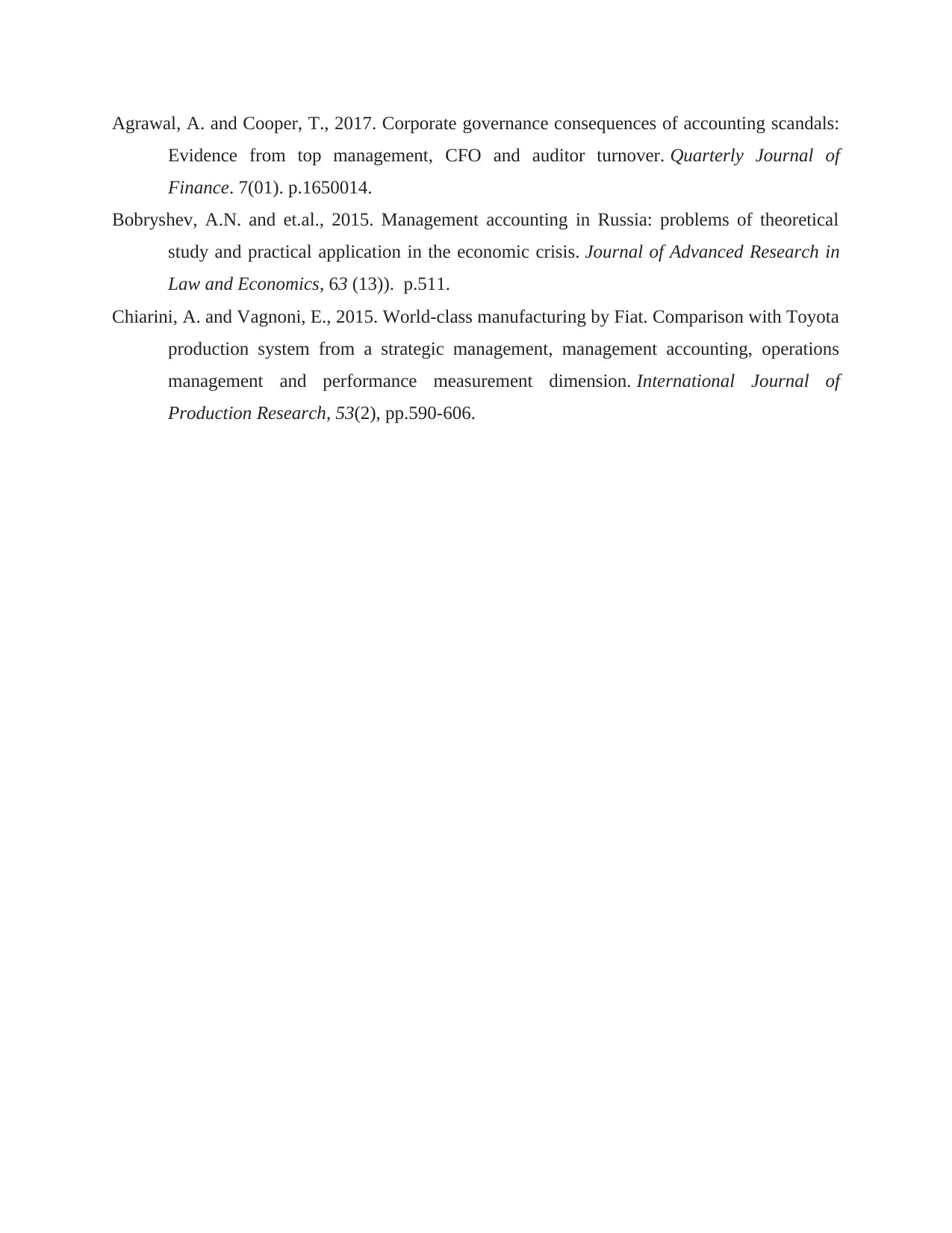
Agrawal, A. and Cooper, T., 2017. Corporate governance consequences of accounting scandals:
Evidence from top management, CFO and auditor turnover. Quarterly Journal of
Finance. 7(01). p.1650014.
Bobryshev, A.N. and et.al., 2015. Management accounting in Russia: problems of theoretical
study and practical application in the economic crisis. Journal of Advanced Research in
Law and Economics, 63 (13)). p.511.
Chiarini, A. and Vagnoni, E., 2015. World-class manufacturing by Fiat. Comparison with Toyota
production system from a strategic management, management accounting, operations
management and performance measurement dimension. International Journal of
Production Research, 53(2), pp.590-606.
Evidence from top management, CFO and auditor turnover. Quarterly Journal of
Finance. 7(01). p.1650014.
Bobryshev, A.N. and et.al., 2015. Management accounting in Russia: problems of theoretical
study and practical application in the economic crisis. Journal of Advanced Research in
Law and Economics, 63 (13)). p.511.
Chiarini, A. and Vagnoni, E., 2015. World-class manufacturing by Fiat. Comparison with Toyota
production system from a strategic management, management accounting, operations
management and performance measurement dimension. International Journal of
Production Research, 53(2), pp.590-606.
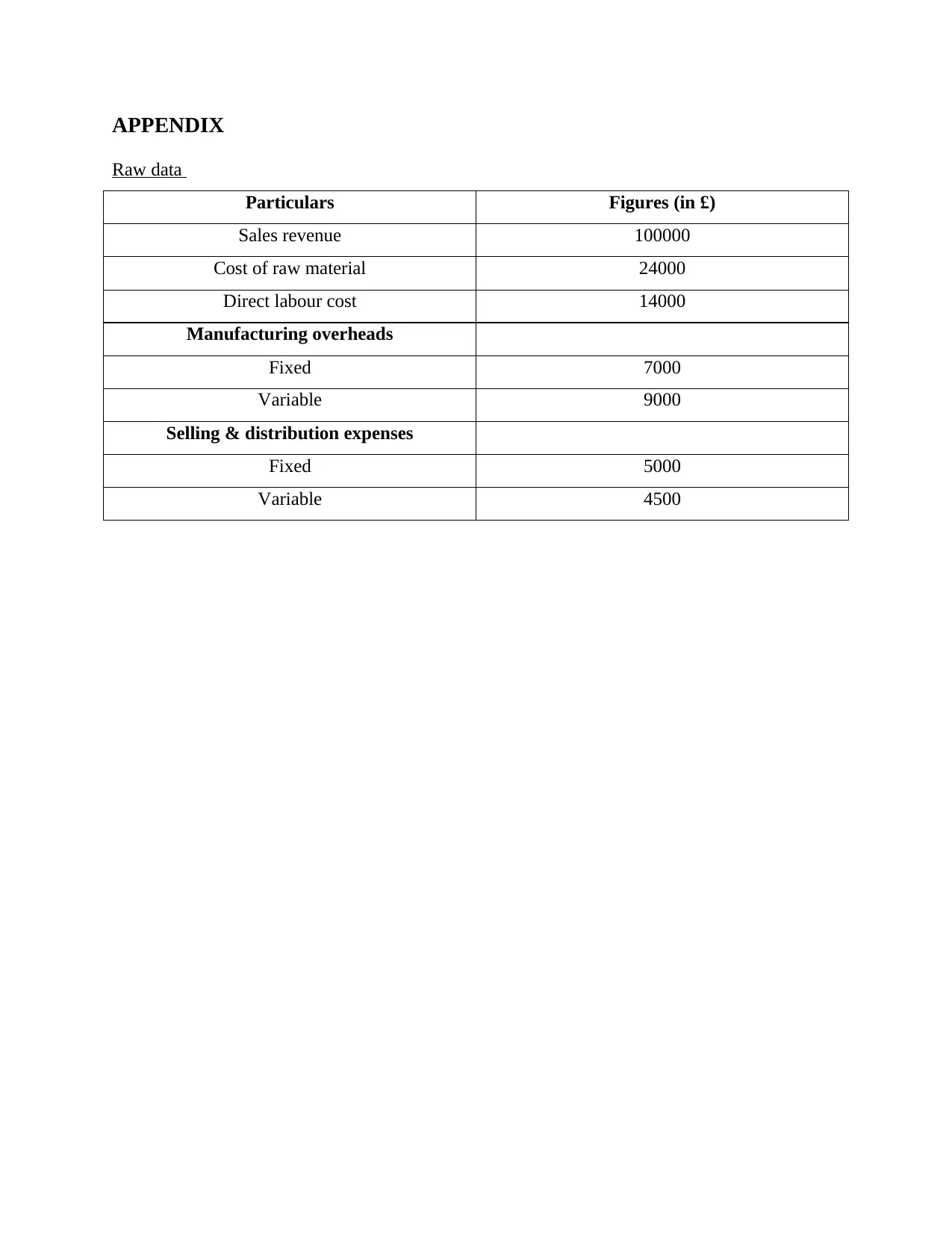
APPENDIX
Raw data
Particulars Figures (in £)
Sales revenue 100000
Cost of raw material 24000
Direct labour cost 14000
Manufacturing overheads
Fixed 7000
Variable 9000
Selling & distribution expenses
Fixed 5000
Variable 4500
Raw data
Particulars Figures (in £)
Sales revenue 100000
Cost of raw material 24000
Direct labour cost 14000
Manufacturing overheads
Fixed 7000
Variable 9000
Selling & distribution expenses
Fixed 5000
Variable 4500
1 out of 19
Related Documents
Your All-in-One AI-Powered Toolkit for Academic Success.
+13062052269
info@desklib.com
Available 24*7 on WhatsApp / Email
![[object Object]](/_next/static/media/star-bottom.7253800d.svg)
Unlock your academic potential
© 2024 | Zucol Services PVT LTD | All rights reserved.





